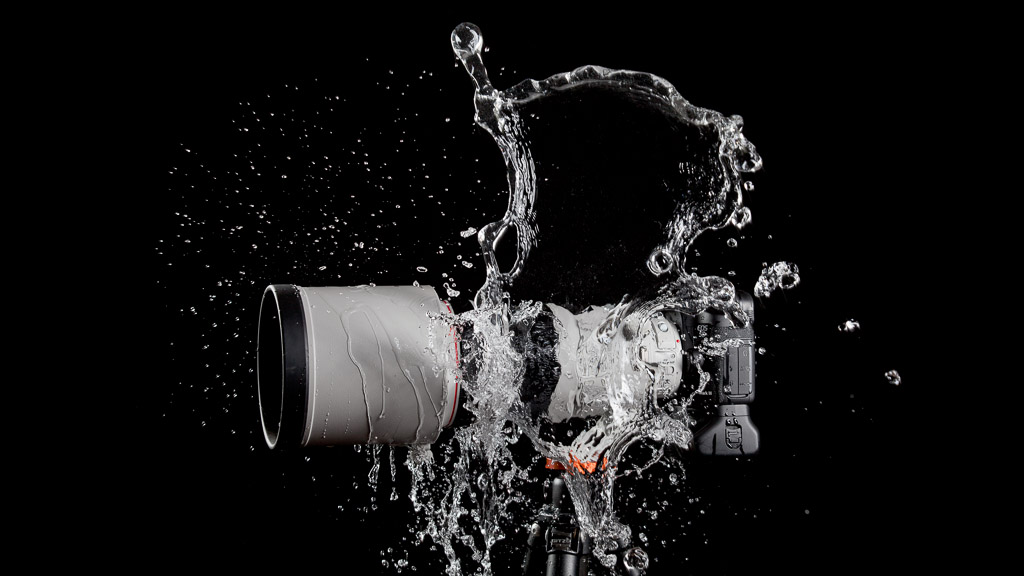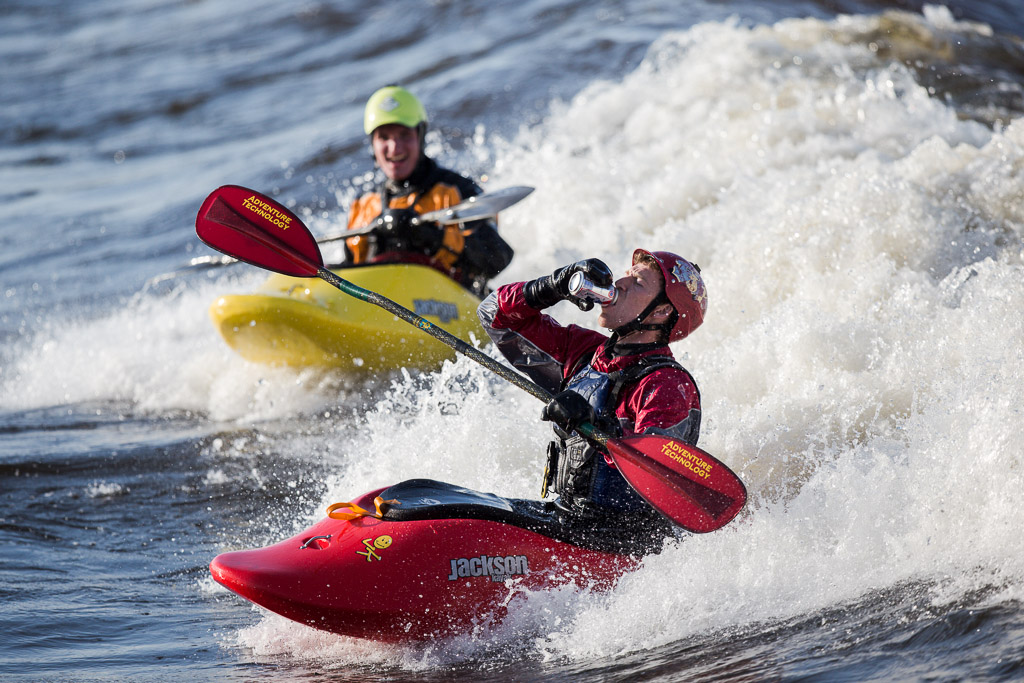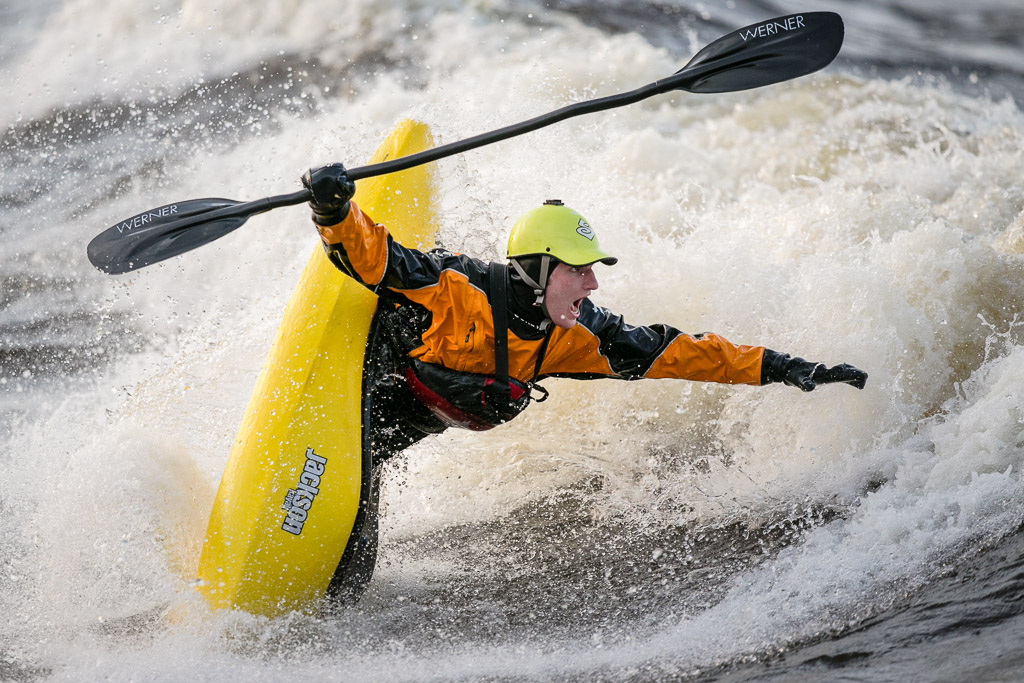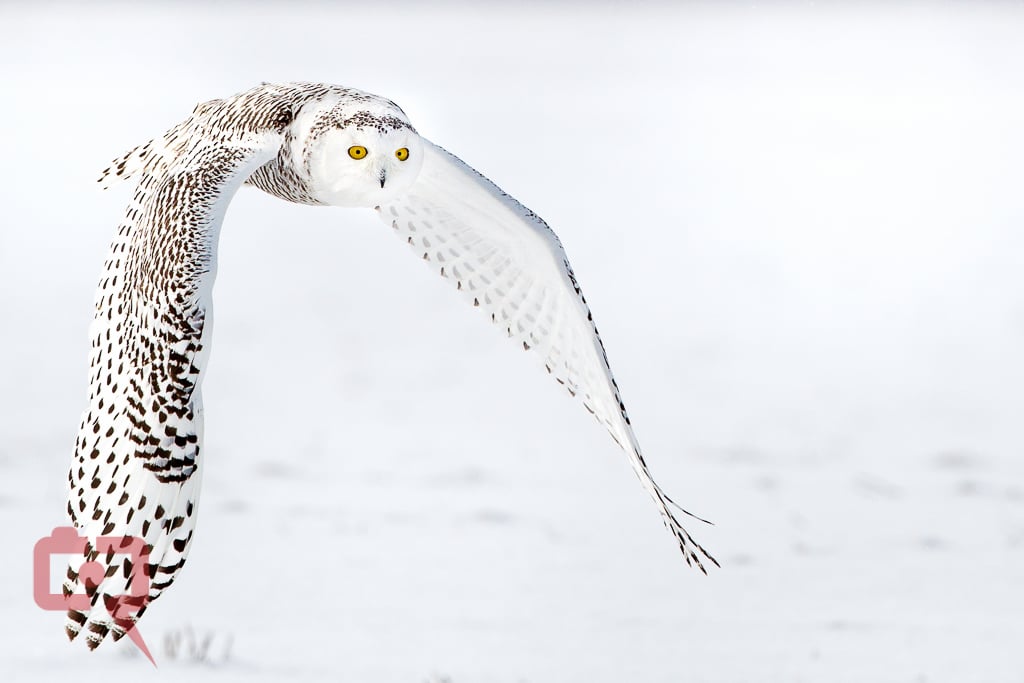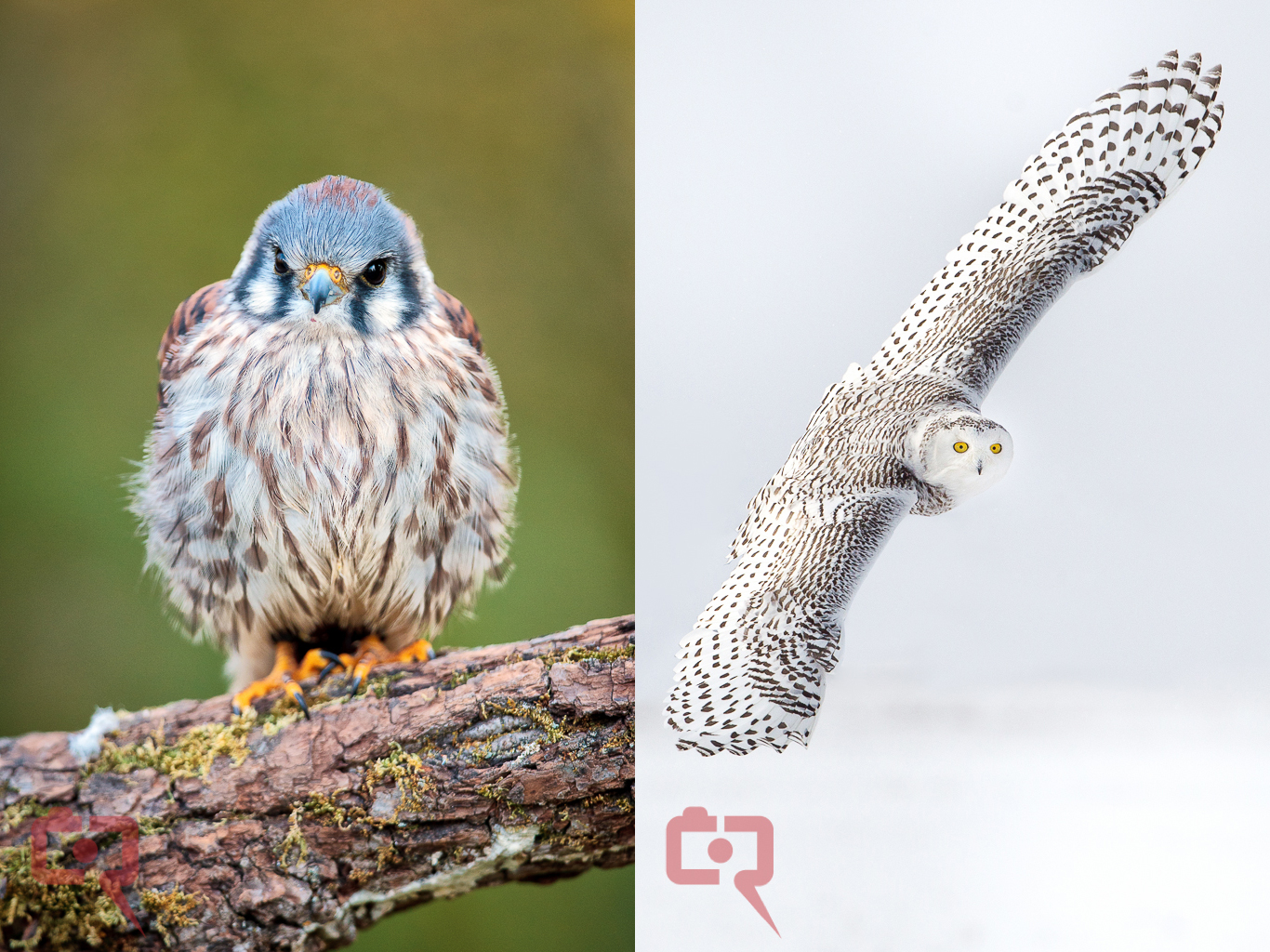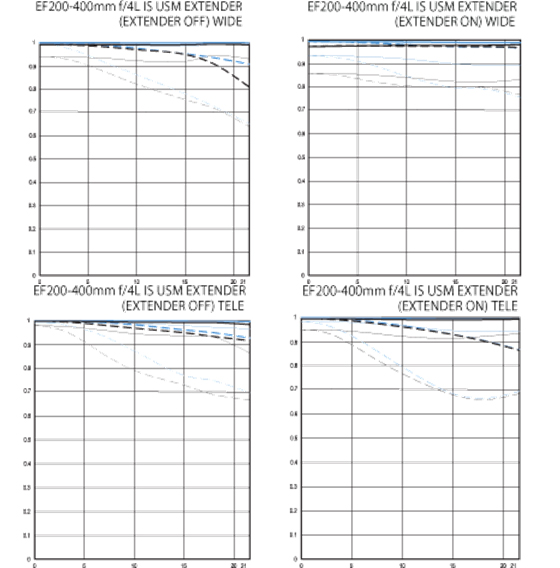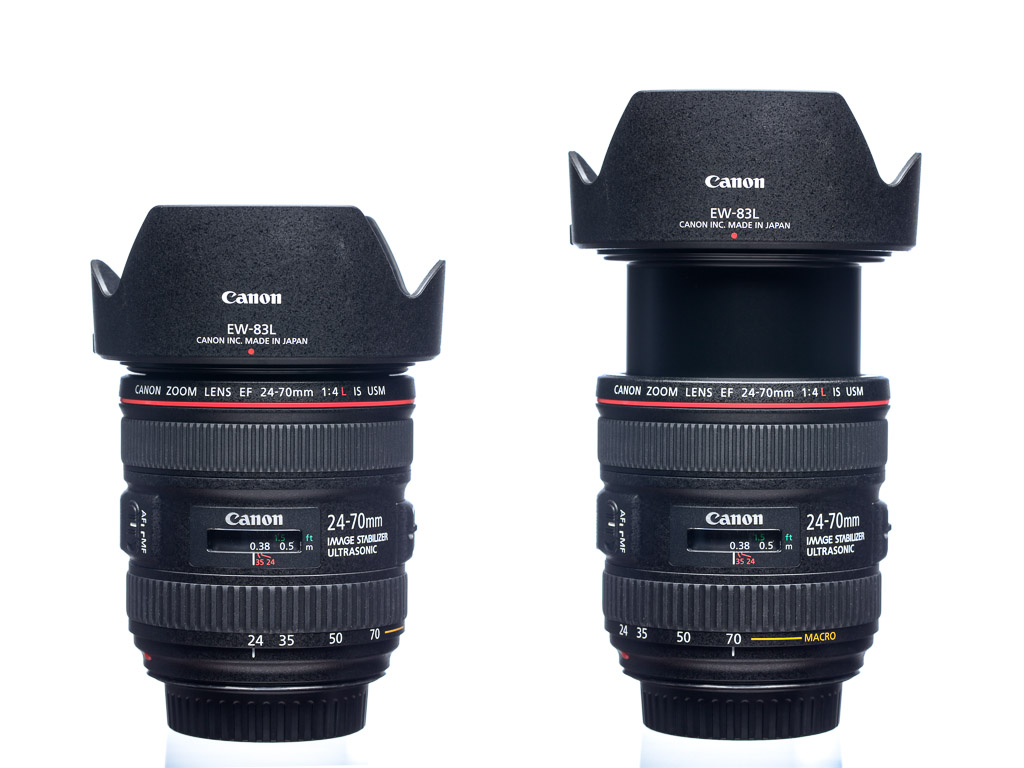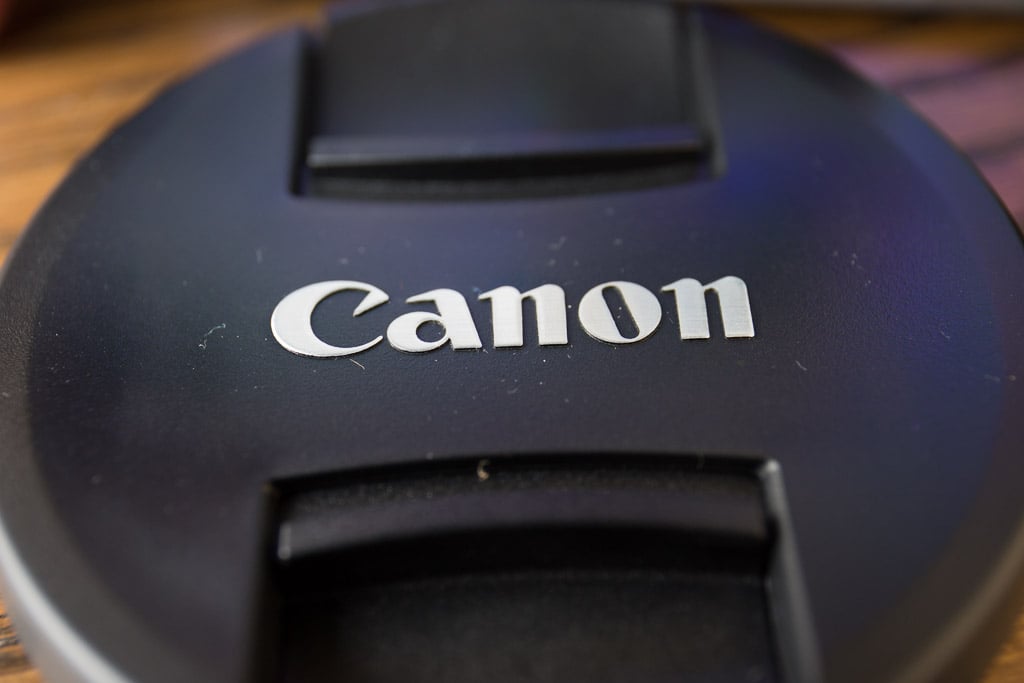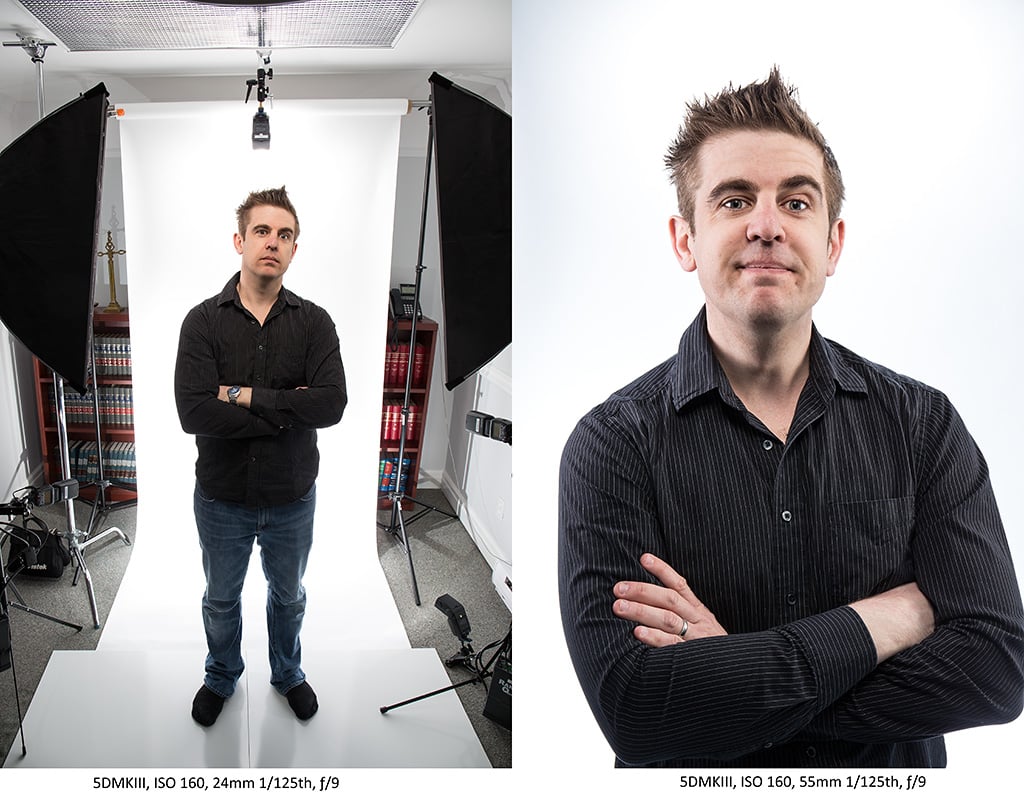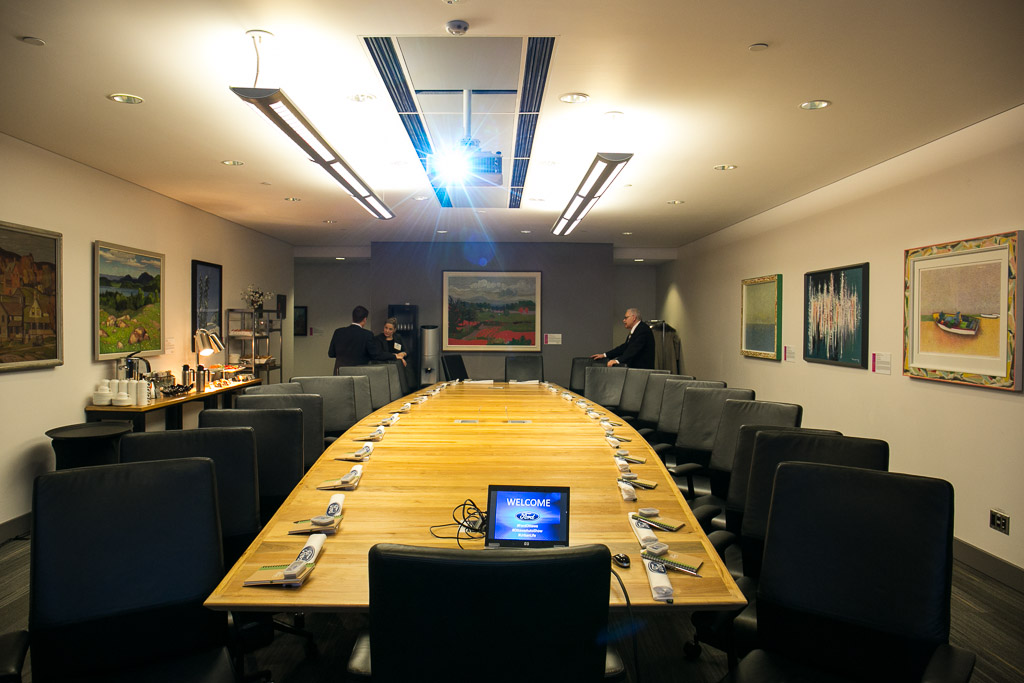venerdì 31 maggio 2013
Video: How Carl Zeiss’ New Touit Lenses Are Manufactured
Samyang 16mm f/2 ED AS UMC CS

5D Mark III & RAW Video, A Case Study
giovedì 30 maggio 2013
Firmware Canon EOS-1D X

Firmware Version 1.2.4 incorporates the following functional improvements and fixes:
- Improves the speed of the camera’s acquisition of focus when using a Canon Speedlite’s AF-assist beam.
- Reduces the time it takes to display the metering result on the LCD or Viewfinder when the meter has been activated.
- Fixes a phenomenon in which a “Caution 02” message is unnecessarily recorded in the camera status log.
- Fixes a phenomenon in which continuous shooting pauses when using a Canon Speedlite.
- Fixes a phenomenon, when the Canon GP-E1 is attached, in which the GPS device settings are reset to default settings when the camera has been powered off
*This phenomenon occurs only with firmware Ver. 1.2.1.
*After changing the GPS device settings, please be sure to power off the camera before removing the battery. This will ensure that the camera’s GPS device settings will be saved.
Firmware Version 1.2.4 is for cameras with firmware version 1.2.1 or earlier. If your camera’s firmware is already Version 1.2.4, it is not necessary to update the firmware. When updating your camera’s firmware, please review the instructions thoroughly before you update the firmware. The firmware update takes approximately seven minutes.
DOWNLOAD FIRMWARE
mercoledì 29 maggio 2013
Fujifilm X-E1 Firmware Update 1.05

Fuji has posted a firmware update for the Fujifilm X-E1 compact system
camera. Version 1.05 improves auto focus speed with
the XF55-200mmF3.5-4.8 R LM OIS lens. You can download the firmware
upgrade from the website below.
Website: Fuji X-E1 Firmware Update Ver.1.05
Fujifilm X-Pro1 Firmware Update 2.04

Fujifilm has issued a firmware update for the Fujifilm X-Pro1 compact
system camera. Version 2.04 improves auto focus speed with the
XF55-200mmF3.5-4.8 R LM OIS lens. You can download the firmware upgrade
from the website below.
Website: Fuji X-Pro1 Firmware Update Ver.2.04
Nikon Coolpix P7700 Firmware Update 1.2

Nikon has released a firmware update for its Coolpix P7700 digital compact camera. According to the company, Version 1.02 fixes the following bugs:
"When shooting with shooting mode set to M (manual), ISO sensitivity
set to Auto, ISO 80-200, ISO 80-400, or ISO 80-800 and the flash used,
ISO sensitivity was sometimes not locked at ISO 80 and a different ISO
sensitivity was sometimes applied."
lunedì 27 maggio 2013
A Cinema Camera for $500: Magic Lantern Unlocks RAW Video in the Old Canon 50D
The Magic Lantern team deserve some sort of award … or a ribbon … or at the very least a hug. That’s because, lately, they’ve been making ground-breaking RAW video announcements almost weekly. From the very beginning of the story — when they discovered a RAW DNG output in live view — to the breakthrough when they began pulling in that stream at 24fps and full 1080p HD, it’s been nothing but good news out of the Magic Lantern camp.
But get ready, because the celebration is only just beginning. Before now, taking advantage of Magic Lantern’s RAW video capability would have required you to have a 5D Mark III or II, but EOSHD forum user Julian Huijbregts has demonstrated that the same is now possible out of Canon’s 5-Year-Old $500 50D!
No, you didn’t read that wrong. For under $500 on eBay, you can now purchase what amounts to a Canon Cinema Camera that can shoot RAW video nearing 1080p full HD resolution. The software is very early in development, so improvements are bound to surface, but for now Huijbregts was able to shoot resolutions as high as 1592×720 at 24fps with no frame skipping using a SanDisk 32GB 95MB/s card:
As it turns out, the 50D — which was released at the same time as the 5D Mark II — has always had video capability, it was just locked out in firmware. Additionally, because it came out before the pixel war really took effect, its 15-megapixel sensor performs extremely well in low-light. Couple that with the fact that it comes equipped with a UDMA 6 CF card slot for high transfer rates, a large buffer and a more professional-style build than its successor, the 60D, and it almost seems like this kind of high-end video is what the 50D was born to do. If you don’t mind skipped frames after the first 50, the current ML build can push the 50D to collect 24p RAW video at up to 1592 × 1062. Given some time (and, at this rate, not that much of it) the team will very likely manage to push RAW video on this extremely cheap APS-C cam to 1080p full HD. That’s all we know for now. To see all of Huijbregts’ results — including an anamorphic test, original DNG files, moire test and sample videos processed in Magic Lantern’s RAW mode — click here to download his full 50D sample pack. (via EOSHD)
Will Third Party Firmware Void Your Canon Warranty?

DIY Photography did a great article on third party firmware and whether or not it voids your warranty. They did it for various brands including Canon, Nikon and Panasonic. Of the three, only Canon is “okay” with you using third party firmware and your warranty will not be “voided”. The only catch is if you “brick” the camera and it’s related to third party software, Canon will not cover that repair.
Canon’s Response
“There is no such thing as “voiding” the Canon warranty, there are simply repairs that are covered, and those that are not.
For instance, the repairs for a failure of the buttons on the back of the camera within the warranty period, on a camera that does not show any evidence of mishandling or misuse, would likely be covered. Repairs for a camera that is “bricked” or otherwise having issues directly related to using a third party firmware would not be covered.”
EOS-1 Bodies
Canon doesn’t mention anything about EOS-1 bodies and third party firmware in the above story. However, I have been told Canon would take legal action against anyone publicly releasing unauthorized firmware for the EOS-1 bodies, so this is probably why we haven’t seen any development of such software.
You can read the entire article at DIY Photographer
venerdì 24 maggio 2013
Adorama Flashpoint 180 Monolight and Battery Kit

Adorama has begun selling the new Flashpoint 180 Monolight Kit.
Compact and ideal for on-location shooting, the Flashpoint 180 Monolight
includes a Flashpoint 180 Monolight with reflector, Bowens-compatible
mount and handle, two NP-F960 batteries with a charger, a small
umbrella, sync cords and a carrying bag. The Flashpoint 180 Monolight
Kit is available now for $199.95 (regularly $249.95).
Adorama Press Release
Adorama Introduces the Flashpoint 180 Monolight and Battery Kit
The professional all-in-one lighting kit now available at the special price of $199.95 for a limited time only
New York, NY – May 20, 2013 – Adorama, one of the world’s largest photography, imaging, video and electronics retailers, and a leading destination for iPhone photo specialty accessories,
is now selling the new Flashpoint 180 Monolight Kit. The Flashpoint 180
Monolight is compact and ideal for on-location shooting. Lightweight
and versatile, the complete lighting kit comes pre-loaded with all the
accessories needed to achieve the perfect lighting for any shoot,
including a case to carry it all. Two readily available NP-F960
batteries power the light, providing up to 700 flashes at a full 180w/s
and giving photographers ultimate control for all of their lighting
needs. The Bowens-compatible mount enables the use of advanced light
modifiers, such as beauty dishes, while the Flashpoint Bowens Speed Ring
Adapter allows the use of soft boxes and other lighting accessories to
help deliver flawless results.
The Flashpoint 180 Monolight Kit Ships With:
• Flashpoint 180 Monolight with reflector and handle
• Batteries and charger
• Small umbrella
• Cords
• Carrying bag
• Flashpoint 180 Monolight with reflector and handle
• Batteries and charger
• Small umbrella
• Cords
• Carrying bag
Visit the Adorama Learning Center to learn more about monolights,
explore the meaning of watt-seconds, and find out how the right light
can transform a photograph.
Special Pricing and Availability
The Flashpoint 180 Monolight Kit is available now for 199.95 USD (regularly 249.95 USD) and ships for free (7-10 day delivery) when ordered online at http://www.adorama.com The k.it is also available at the Adorama superstore located at 42 West 18th Street New York, NY 10011.
The Flashpoint 180 Monolight Kit is available now for 199.95 USD (regularly 249.95 USD) and ships for free (7-10 day delivery) when ordered online at http://www.adorama.com The k.it is also available at the Adorama superstore located at 42 West 18th Street New York, NY 10011.
Flashpoint is Adorama’s in-house brand, featuring high-quality photo
and video accessories and gear, such as the Flashpoint 180 Monolight
Kit, at price points lower than competing name brands such as Profoto
and Smith Victor.
ABOUT ADORAMA
ADORAMA: More Than a Camera Store
Adorama is more than a camera
store – it’s one of the world’s largest photography, imaging and
electronics retailers. Serving customers for more than 30 years, Adorama
has grown from its flagship NYC store to include the leading online
destination for photography, imaging and consumer electronics. Adorama's
vast product offerings encompass home entertainment, mobile computing,
and professional video and audio, while its services include an in-house
photo lab, AdoramaPix, pro equipment rental at Adorama Rental Company
and the award-winning Adorama Learning Center, which offers free
education for photographers in video channels such as the popular
AdoramaTV.
Adorama is listed as Forbes.com’s "Best of the Web" and in the Internet
Retailers Top 100, and is the official Photo and Electronics Retailer
of the NY Giants.
Visit ADORAMA at http://www.adorama.com
Xara Photo & Graphic Designer 9

Xara has released version 9 of its Windows-based creative design
software, Xara Photo and Graphics Designer. New features include an
advanced healing brush, 11 new photo effects, Google font support, new
masking and selection tools, advanced background erasing options and
more. Xara Photo & Graphic Designer 9 costs £69.99.
Xara Press Release
New Xara Photo & Graphic Designer v9
New Xara Photo & Graphic Designer v9
21st May, 2012 - Xara today announced the release of the
latest new version of their creative design software, Xara Photo and
Graphics Designer v9.
Xara Photo & Graphic Designer is ideal for any graphics enthusiast, small company or academic user that requires the best value general purpose photo and graphic design tool.
Xara Photo & Graphic Designer is ideal for any graphics enthusiast, small company or academic user that requires the best value general purpose photo and graphic design tool.
The headline new features include:
Advanced Healing Brush – remove blemishes with a single click, or brush over an area to erase it.
New Mask and Selection tools. Easily paint, or draw a region or area to enhance, such as adjust the brightness, sharpness, color temperature etc.
New Mask and Selection tools. Easily paint, or draw a region or area to enhance, such as adjust the brightness, sharpness, color temperature etc.
Advanced background erase. Extract complex shapes such a people or
objects in the foreground, and place them on alternate backgrounds.
Drag and drop re-colouring of clipart and vector groups.
Drag and drop re-colouring of clipart and vector groups.
Google Font support. Browse, preview and install any of the 600+ Google
Fonts. Although Google Fonts were primarily designed to be web fonts,
they are open source Truetype or OpenType fonts and Xara has built in a
way to automatically download and install the font as a Windows font.
11 new Photo Effects including Fake HDR, Polarized Grayscale and Color Splash to highlight a color.
New clipart including a wide range of ‘company logo’ designs
New clipart including a wide range of ‘company logo’ designs
Most of Xara's photo editing tools are non-destructive. Also known as
'parametric image editing', this non-destructive technique allows you to
adjust or even remove edits at any point in the future, without
affecting the original image. Photo edits are stored as the parameters
to be changed (such as brightness or blend levels) rather than the
altered pixels. This is much faster, more powerful, more memory
efficient, and allows near infinite Undo.
Xara Photo and Graphic Designer introduces some really advanced photo editing features. An automatic background erase that normally takes hours of careful manual masking (or would be impossible), can be done in seconds. The Healing Brush is built on what Xara believe to be the most advanced intelligent 'fill in' algorithms anywhere. The new Mask and Selection tools make it easier than ever to apply edits to specific areas, and to have those edits seamlessly blended into your photo.
Xara Photo and Graphic Designer introduces some really advanced photo editing features. An automatic background erase that normally takes hours of careful manual masking (or would be impossible), can be done in seconds. The Healing Brush is built on what Xara believe to be the most advanced intelligent 'fill in' algorithms anywhere. The new Mask and Selection tools make it easier than ever to apply edits to specific areas, and to have those edits seamlessly blended into your photo.
Charles Moir, Managing Director of Xara said: "As the name suggests
'Photo & Graphic Designer' is more than just another photo editor.
It's one of the most advanced and powerful vector graphics programs
available, and seamlessly combines all the photo editing features you're
likely to need. Why should you have to use one program for general
vector 'artwork' style graphics and another for photo editing, when you
can get one, really fast, really easy-to-use graphics program that does
it all? It's simply the most advanced photo and graphics editing tool
available, for the money."
Xara Photo & Graphic Designer 9 costs just £69.99 (inc VAT)
Upgrades from v8 to Xara Photo & Graphic Designer 9 cost £35 (inc VAT)
Xara Photo & Graphic Designer 9 costs just £69.99 (inc VAT)
Upgrades from v8 to Xara Photo & Graphic Designer 9 cost £35 (inc VAT)
It operates on Windows XP/Vista/7/8
For more information see - xara.com
Demonstration pages of the new features - xaragroup.magix.net/PGD9Demo1/
For more information see - xara.com
Demonstration pages of the new features - xaragroup.magix.net/PGD9Demo1/
Corel Launches Special Pricing Programme for Creative Suite Users

Corel
today announced a special pricing programme specifically for Creative
Suite users looking for an alternative to Creative Cloud. CS users
residing in North America can purchase CorelDRAW Graphics Suite,
Painter, PaintShop Pro, VideoStudio Pro and AfterShot Pro at a special
price (ranging up
to 60% off the suggested retail price) until 30 August 2013. To
experiment with the tools, features and workflow of Corel products, free
30-day fully functional trials can be downloaded from the website
below.
Website: Corel
Corel Press Release
Corel Offers Powerful Alternatives to Creative Cloud
Creative Suite Users Looking for Options Can Benefit From Special Pricing
Maidenhead, UK – Wednesday 22 May, 2013 – Corel today announced a
special pricing program specifically for Creative Suite users looking
for an alternative to Creative Cloud. As some software companies move to
subscription only models, Corel continues to offer users the
flexibility to choose how they want to purchase and experience Corel
products. Creative Suite users are invited to try or purchase
award-winning Corel software including CorelDRAW Graphics Suite, Painter, PaintShop Pro, VideoStudio Pro and AfterShot Pro at a special price (ranging up to 60% off SRP).
“We strongly believe that users should be able to choose how they would
like to purchase their software,” said Nick Davies, EVP & GM
Graphics, Digital Media & Productivity Software at Corel. “We
recognise that there isn’t one solution that will work for everyone,
which is why we have different offerings for the diverse products in our
portfolio. We will continue to sell perpetual licenses in both the box
and download format, in addition to offering CorelDRAW subscriptions and
more, in order to meet the needs of our users.”
Corel Offers Best of Both Worlds
Whether users are looking for a short-term commitment or want to always
be up-to-date but own their software, Corel delivers the options and
flexibility to cater to diverse users. In addition to a subscription or
perpetual license of CorelDRAW® Graphics Suite, the CorelDRAW Premium
Membership program adds the benefits of a subscription (always
up-to-date, exclusive content and more) to the perpetual usage right of
the product, offering the best of both worlds.
Take Corel Products for a Test Run
To experiment with the tools, features and workflow of Corel products,
free 30-day fully functional trials can be downloaded at http://www.corel.com/cs
Learning resources are available within the product and through the
Corel Discovery Center to ease into the transition and become more
familiar with the power of Corel products.
“I'm a graphic designer by trade and I've tried just about every
professional design application out there, but CorelDRAW Graphics Suite
X6 trumps them all” said Scott Huff, CorelDRAW user. “The streamlined
interface is highly customisable with dockers and tools that are useful
and intuitive. The integration within the applications means I never
need to leave my Corel environment. From initial sketches to final proof
I complete my work in a fraction of the time it takes using the
competition's top tools.”
Pricing
The following offer is available for Creative Suite users in North America until August 30, 2013:
CorelDRAW® Graphics Suite X6 – £215 (SRP £479)
Painter® 12 – £143 (SRP £275)
PaintShop® Pro X5 – £44.99 (SRP £59.99)
VideoStudio® Pro X6 – £44.99 (SRP £59.99)
AfterShot™ Pro – £59.99 (SRP £80)
To learn more about the special offer or to purchase, visit http://www.corel.com/cs
.
Join the Corel Community
Connect with us on Facebook at http://www.facebook.com/corel
Follow us on Twitter at @corelsoftware
Share with us on Pinterest at http://www.pinterest.com/corelsoftware
Read our blog at http://www.corel.com/blog
About Corel
Follow us on Twitter at @corelsoftware
Share with us on Pinterest at http://www.pinterest.com/corelsoftware
Read our blog at http://www.corel.com/blog
About Corel
Corel is one of the world's top software companies providing some of the industry's best-known brands, including Corel®, Roxio®,
Pinnacle™ and WinZip®. Boasting the most comprehensive portfolio of
graphics, productivity and digital media products, we've built a
reputation for delivering innovative software that’s easy to learn and
use, helping people achieve new levels of creativity and productivity.
The industry has responded with hundreds of awards for innovation,
design and value.
Used by millions of people around the world, our product lines include
CorelDRAW® Graphics Suite, Corel® Painter®, Corel® PaintShop® Pro,
Corel® VideoStudio®, Corel® WordPerfect® Office, Pinnacle Studio™, Roxio Creator®, Roxio® Toast® and WinZip®. For more information on Corel, please visit http://www.corel.com
.
© 2013 Corel Corporation. All rights reserved. Corel, the Corel
logo, the Corel Balloon logo, CorelDRAW, PaintShop, Painter, Pinnacle,
Roxio, Roxio Creator, Toast, VideoStudio and WordPerfect are trademarks
or registered trademarks of Corel Corporation and/or its subsidiaries.
WinZip is a registered trademark of WinZip International LLC. All other
names and any registered and unregistered trademarks mentioned are used
for identification purposes only and remain the exclusive property of
their respective owners.
Photodex Sports & Action Effects Pack for ProShow

Photodex have released their new Sports & Action Effects Pack for
ProShow. The pack includes a dynamic array of "sporty" transitions, edgy
photo layouts and titles, and digital 'player stats' cards, ideal for photographers covering an end of season wrap-up,
a game victory, or team portrait showcase. "From sports photographers
to proud parents on the sidelines, more and more digital photos and
videos are being captured at sporting events", said Paul Schmidt
president and founder of Photodex. "ProShow makes it easy to turn those
digital files into shareable memories. Our new Sports & Action
effects pack offers up some fun and energetic animations that can really
amp-up sports slideshows." The Photodex Sports & Action Effects
Pack is available now for $19.95.
Photodex Press Release
Photodex Releases New Sports & Action Effects Pack for ProShow
Austin, TX, May 21, 2013 - Photodex today announced the
release of their new Sports & Action Effects Pack for ProShow, an
award-winning slideshow tool that lets people easily combine photos,
video clips and music into a polished video.
The first of its kind, the Sports & Action Effects Pack stacks its
lineup with a combination of slide styles and transitions, offering a
well-rounded powerhouse of premium effects for sports slideshows. The
pack includes a dynamic array of sporty transitions, edgy photo layouts
and titles, and digital 'player stats' cards, ideal for photographers
covering an end of season wrap-up, a game victory, or team portrait
showcase.
Unique to this Effects Pack is the option for users to customize the
colors for select slide styles to coordinate with their team's colors.
Also included are digital 'player stats', reminiscent of old school
trading cards, that can be customized to profile an individual athlete
or team. The stats include editable fields for player and team names,
position, coach, hometown and more. The Sports & Action Effects Pack
covers 15 major competitive athletic and performance categories.
"From sports photographers to proud parents on the sidelines, more and
more digital photos and videos are being captured at sporting events",
said Paul Schmidt president and founder of Photodex Corporation.
"ProShow makes it easy to turn those digital files into shareable
memories. Our new Sports & Action effects pack offers up some fun
and energetic animations that can really amp-up sports slideshows."
Pricing and Availablity
The Sports & Action Effects Pack is available now for $19.95. Available for download or on disc from http://www.photodex.com or by calling 1-800-37-PHOTO (1-800-377-4686). Requires ProShow Gold 5, ProShow Producer 5 or ProShow Web.
The Sports & Action Effects Pack is available now for $19.95. Available for download or on disc from http://www.photodex.com or by calling 1-800-37-PHOTO (1-800-377-4686). Requires ProShow Gold 5, ProShow Producer 5 or ProShow Web.
venerdì 17 maggio 2013
Rogue FlashBender XL Pro Lighting Kit Now Available in US

ExpoImaging has announced the US availability of the Rogue FlashBender
XL Pro Lighting Kit. The kit includes a FlashBender XL Pro white
reflector, an XL Pro Strip box diffuser, an XL Soft Box diffuser and a
reversible XL Pro silver/black reflector. The Rogue XL Pro Lighting Kit
is available to buy now, at a guide retail price of $99.95.
Website: ExpoImaging
Press Release
Introducing Rogue FlashBender XL PRO Lighting Kit: Portable
Light Modifiers Include Strip Box, Soft Box, and Shapeable Reflector for
Speedlight Photography
Rogue Photographic Design delivers new Portable Lighting Kit for Speedlights, includes quick change diffusers to create Strip Box, Soft Box, or White / Black / Silver Reflector.
Rogue Photographic Design delivers new Portable Lighting Kit for Speedlights, includes quick change diffusers to create Strip Box, Soft Box, or White / Black / Silver Reflector.
Watsonville, California (PRWEB) May 14, 2013
ExpoImaging, Inc., which markets, designs, manufactures and distributes
innovative camera accessories to the photographic market, today
announced availability of the Rogue FlashBender XL Pro Lighting Kit for
small strobe lighting enthusiasts.
“Photographers using and traveling with speedlights are always looking for ways to do more with less,” said Erik Sowder, CEO of ExpoImaging, Inc. “The new FlashBender XL Pro reflector is larger than anything we’ve designed before and ideally suited for on location off-camera lighting. Included in the kit is a new variable-width strip box diffuser attachment that introduces an entirely new edge lighting tool to the Rogue system.”
“Like our other Rogue FlashBenders, this compact, durable system of flash modifiers packs flat. It’s sized to fit in the most popular roller bags, or into a 17” laptop compartment,” said Sowder.
In studio or on location, the Rogue FlashBender XL Pro Lighting Kit provides more creative lighting control for photographers using small flash. The included quick change attachments make a variable width strip box for background, rim and edge lighting control, a low profile soft box for soft directional light, or a multi-surface white, black, or silver reflector to manipulate contrast.
The Rogue FlashBender XL Pro Lighting Kit includes: Rogue FlashBender XL Pro Reflector, Rogue XL Pro Strip Box Attachment, Rogue XL Pro Soft Box Attachment, Rogue XL Pro Reversible Silver-Black Attachment. Like all FlashBenders, the integrated attachment strap fits all popular brands of shoe mounted flashes.
Pricing and Availability
The Rogue FlashBender XL Pro Lighting Kit is available now through ExpoImaging’s distribution partners worldwide, or online at http://www.expoimaging.com The R.ogue FlashBender XL Pro Lighting Kit retails for $99.95.
About Rogue Photographic Design
Created by ExpoImaging, Rogue Photographic Design is a growing line of innovative lighting equipment for speedlight enthusiasts. Compact, versatile, and durable, patented Rogue light modifiers offer unparalleled lighting control and creative possibility in a minimum amount of space. More information about offerings from Rogue Photographic Design is available at http://www.expoimaging.com
.
About ExpoImaging, Inc.
ExpoImaging, Inc. markets, designs, manufactures and distributes innovative camera accessories to the photographic market. ExpoImaging is the pioneer in white balance filters and manufactures ExpoDisc White Balance Filters, Rogue FlashBenders, Rogue Diffusion Panels, Rogue Grid, Rogue Flash Gels, and the ExpoAperture2 Depth-of-Field Guide. ExpoImaging is also the exclusive U.S. distributor of Ray Flash: The Ring Light Adapter. These unique products are available at select photography dealers worldwide or online at http://www.expoimaging.com
.
“Photographers using and traveling with speedlights are always looking for ways to do more with less,” said Erik Sowder, CEO of ExpoImaging, Inc. “The new FlashBender XL Pro reflector is larger than anything we’ve designed before and ideally suited for on location off-camera lighting. Included in the kit is a new variable-width strip box diffuser attachment that introduces an entirely new edge lighting tool to the Rogue system.”
“Like our other Rogue FlashBenders, this compact, durable system of flash modifiers packs flat. It’s sized to fit in the most popular roller bags, or into a 17” laptop compartment,” said Sowder.
In studio or on location, the Rogue FlashBender XL Pro Lighting Kit provides more creative lighting control for photographers using small flash. The included quick change attachments make a variable width strip box for background, rim and edge lighting control, a low profile soft box for soft directional light, or a multi-surface white, black, or silver reflector to manipulate contrast.
The Rogue FlashBender XL Pro Lighting Kit includes: Rogue FlashBender XL Pro Reflector, Rogue XL Pro Strip Box Attachment, Rogue XL Pro Soft Box Attachment, Rogue XL Pro Reversible Silver-Black Attachment. Like all FlashBenders, the integrated attachment strap fits all popular brands of shoe mounted flashes.
Pricing and Availability
The Rogue FlashBender XL Pro Lighting Kit is available now through ExpoImaging’s distribution partners worldwide, or online at http://www.expoimaging.com The R.ogue FlashBender XL Pro Lighting Kit retails for $99.95.
About Rogue Photographic Design
Created by ExpoImaging, Rogue Photographic Design is a growing line of innovative lighting equipment for speedlight enthusiasts. Compact, versatile, and durable, patented Rogue light modifiers offer unparalleled lighting control and creative possibility in a minimum amount of space. More information about offerings from Rogue Photographic Design is available at http://www.expoimaging.com
.
About ExpoImaging, Inc.
ExpoImaging, Inc. markets, designs, manufactures and distributes innovative camera accessories to the photographic market. ExpoImaging is the pioneer in white balance filters and manufactures ExpoDisc White Balance Filters, Rogue FlashBenders, Rogue Diffusion Panels, Rogue Grid, Rogue Flash Gels, and the ExpoAperture2 Depth-of-Field Guide. ExpoImaging is also the exclusive U.S. distributor of Ray Flash: The Ring Light Adapter. These unique products are available at select photography dealers worldwide or online at http://www.expoimaging.com
Included in the Kit:
1x XL Pro FlashBender White Reflector
1x XL Pro Strip Box Diffuser Attachment
1x XL Pro Soft Box Diffuser Attachment
1x XL Pro Silver/Black Reflector Attachment
1x XL Pro FlashBender White Reflector
1x XL Pro Strip Box Diffuser Attachment
1x XL Pro Soft Box Diffuser Attachment
1x XL Pro Silver/Black Reflector Attachment
Logistics Manager 30

Think Tank Photo has released its newest rolling camera bag, the
Logisitcs Manager 30. A new version of the company's popular
large-capacity roller bag, the Logisitics Manager 30 holds multiple
combinations of cameras
and lenses, lighting gear such as strobes and reflectors, and
accessories of all kinds. The internal dimensions are 35x70 x21–25.5cm,
and the bag also has both internal and side pockets - as well as a large
front organiser pocket - for various items. The Think Tank Photo
Logistics Manager 30 is available for $499.75 via the website below.
Website: Think Tank Photo
Think Tank Photo Press Release
Think Tank Photo’s Releases Logistics Manager™ 30 Large Capacity Rolling Camera Bag
Santa Rosa, Calif. – Think Tank Photo announces the release of
a new version of its popular large capacity rolling camera bag, the
Logistics Manager™ 30. The rolling case’s endless interior layout
options adapt to numerous equipment combinations and help manage all of
the logistics of transporting and using a lot of gear while on location.
Its roomy internal dimensions of 13.75”W x 27.5”H x 8.25 – 10”D (35 x 70 x 21 – 25.5cm) allow it to hold multiple combinations of cameras and lenses, lighting gear such as strobes and reflectors, and accessories of all kinds.
Key Features
Holds and transports all types of gear on location.
Organizer side pocket for various equipment.
Interior pockets for extra organization.
Two clear accessory bags included for miscellaneous items.
Quickly deployable roller handle.
Large front organizer pocket.
Expandable front pocket for large items.
TSA-approved main zipper lock for added security.
Tripod cup, strap, and rain cover included.
Its roomy internal dimensions of 13.75”W x 27.5”H x 8.25 – 10”D (35 x 70 x 21 – 25.5cm) allow it to hold multiple combinations of cameras and lenses, lighting gear such as strobes and reflectors, and accessories of all kinds.
Key Features
Holds and transports all types of gear on location.
Organizer side pocket for various equipment.
Interior pockets for extra organization.
Two clear accessory bags included for miscellaneous items.
Quickly deployable roller handle.
Large front organizer pocket.
Expandable front pocket for large items.
TSA-approved main zipper lock for added security.
Tripod cup, strap, and rain cover included.
“The Logistics Manager 30 answers a question often asked by working
photographers: ‘How can I transport all of my gear into the field, have
quick access to it, and secure it from loss or theft?’” said Doug
Murdoch, Think Tank Photo president and lead designer. “We took the
design and engineering principles we pioneered in our line-up of
award-winning rolling camera bags and applied them to this very roomy
pro photographer logistics solution.”
Specifications
Internal Dimensions: 13.75”W x 27.5”H x 8.25 – 10”D (35 x 70 x 21 – 25.5cm)
External Dimensions: 15.75”W x 30”H x 11.5”D (40 x 76 x 29cm)
Weight: 16 – 20 lbs (7.3 – 9.1 kg) (depending on accessories used)
Internal Dimensions: 13.75”W x 27.5”H x 8.25 – 10”D (35 x 70 x 21 – 25.5cm)
External Dimensions: 15.75”W x 30”H x 11.5”D (40 x 76 x 29cm)
Weight: 16 – 20 lbs (7.3 – 9.1 kg) (depending on accessories used)
Review – Canon EF 300mm f/2.8L IS II
Review – Canon EF 300mm f/2.8L IS II
By: Justin VanLeeuwen | Twitter
Discuss the Canon EF 300 f/2.8L IS II
There’s a certain threshold you can pass in your lens acquisitions where usefulness, desire, and expanded needs meet. Perhaps in no place is this more true than when entering the super-telephoto range; extending 300mm and beyond. With the exception of a few choice zoom lenses, the Canon Super-Telephoto range enters a niche market of primes that serve a very specific purpose beyond what most photographers will encounter in a day (depending, of course, on what you do). I had always been curious about Canon’s 300mm f/2.8 L, and when the 300mm f/2.8 L II was released I was eager to give it a try. Not much longer in range than my Canon 70-200mm f/2.8 L IS II, I thought it could be *handy* to have in situations where a bit of extra reach was needed. But at a retail price in the multiple thousands, “handy” may not cut it as that kind of purchase needs to be justified beyond a desire to fill a focal range gap. The Canon 300mm f/2.8 L IS II is the first in a range of lenses that, in my opinion, serve the purpose to get you closer to your subjects when your movement is otherwise restricted.
Build
We’re clearly looking at a more or less $6,500 “pro” lens here; there’s very little to fault in the sturdy metal construction of the body. While I found handholding it to be completely possible (especially with image stabilization engaged), I don’t recommend spending a full day trying to shoot it without some level of support as the weight will get to you. A sturdy tripod or monopod will go a long way to help you get the shots you want (many of the images I captured here were using a monopod). The large rubber focus ring is incredibly smooth and easy to move as, obviously, a larger lens will accommodate this design feature.
Weather sealing is a must, as many photographers using it will be in unshielded outdoor venues or even near water. As you can see from the image above, I tested its capabilities and I’m happy to report everything still works as it should.
The lens comes with a very large hood which, as always, I do recommend you use not just to protect the front element since there are no screw-on filters of this size, but also to prevent light from entering and flaring-out your images. It may significantly increase the length of the lens, but you’re not buying it to be discreet. The standard longer focal length switches adorn the side include a focus limiter, stabilization ON/OFF, stabilization mode 1/2/3, focus preset modes & the set button, and AF/PF/MF.
A bit on Image Stabilization
“Optical Image Stabilizer technology makes hand-held photography more practical at slow shutter speeds*” (*Canon USA). IS helps free the camera and photographer from the tripod and gives you a bit more latitude to how and where you shoot. As a guide, it’s suggested that photographers’ shutter speeds should match the apparent focal length of the lens. So ideal shutter speeds on a full frame camera like the 1DX, 5DMKIII, or 6D, would be about 1/300th of a second at 300mm – of course this has no bearing on stopping motion or action. On a crop body like the Rebel series, 60D, or 7D you’d be looking to multiply that by the crop factor of the camera (1.6x) so 300mm would be 1/480th of a second, this make sense as the apparent focal length is magnified, so are any potential shakes. The IS advantage, then, is to allow yourself a bit more working room to achieve sharp images. The stabilization compensates for movement and shake, effectively correcting the slight changes the photographer introduces into the image through movement. 4 stops *technically* brings the 1/300th rating down to 1/50th of a second, though excellent technique is still recommended and, again, this won’t’ stop your subject from moving. Obvious advantages to this are people working indoors, where lighting is limited and you don’t need sports-level action stopping shutter speeds.
The mode switch allows for two types of stabilization: 1 is for “regular” use which corrects for vibrations in all direction, while 2 compensates for moving subjects or panning where there is a bit of fluidity and motion already being introduced to the lens to capture an image. Mode three “Corrects vibration only during exposure. During panning shots, corrects vibration during exposure only in one direction the same as MODE 2*.” [Canon USA].
There’s a focus preset button so you can set a specific focusing distance and return to it at any time by rotating the “Playback Ring” (a grooved metal ring between the focus ring and the front rubber grip). The front rubber grip also has four equally placed AF stop buttons which temporarily pause autofocus.
Focus
The principal use of a long range telephoto is sports photography. Often you’ll be facing fast-moving subjects in dynamic environments. While your camera has a lot to do with AF performance and it will ultimately impact how well the lens works, the lens itself needs to be able to perform to high standards. I’m happy to report this lens meets and exceeds any expectations you may have of it. Focus was incredibly fast, quiet, and accurate to a point that any error was likely mine and/or a combination of the auto-focus settings I had enabled on the camera. New to this lens in version 2 is the “PF” focus mode:
“Helping moviemakers achieve smoother and more appealing focus shifts when filming on EOS DSLR cameras, Canon has included a new Power Focus (PF) mode on the company’s two new super telephoto lenses. This mode allows manual rack focusing to be operated smoothly by turning a playback ring that is normally used for the focus preset function. Both low and high speed focus shifting is available” [Canon USA].
 Image
Image
When I first started using the Canon 300mm f/2.8 L IS II, someone I knew mentioned “It doesn’t suck, eh?” and were they right. Rarely did I stop down from f/2.8 – after-all, a fast wide-open aperture to create lovely out of focus backgrounds is part of the appeal – and rarely did I need to. The lens is sharp wide-open, from what I can tell corner to corner. It does vignette slightly, which improves as you stop down but I’m tired of writing about fast lenses and vignetting. THEY ALL VIGNETTE; this isn’t news. I often find the vignette pleasing as it helps to further focus the viewers’ eyes on the subject of your photograph.
I was hard pressed to find any noticeable flaws in the optics either. Chromatic Aberration and fringing were nearly non-existent. Since I used the lens’ hood whenever I was shooting I didn’t encounter any flare, and honestly forgot to shoot into the light to try and challenge the lens itself (also, I find the idea of a 300mm magnification of the sun slightly scary for my camera sensor). At 300mm f/2.8 you’re also looking at incredibly smooth and out of focus backgrounds, an interesting phenomenon is that at a close distance you can introduce minor obstructions like branches and fences and they won’t appear in your final image (though they will influence image quality as they’re just blurred out).
Compression is another great reason to use a telephoto lens, as it helps bring background elements “closer” in a two-dimensional image. Coupled with a particularly close minimum focus distance of 2 meters, there are some unique opportunities but I implore you, please do not use this knowledge for evil. Focusing closely at someone’s face at 300mm will “flatten” the perspective of their entire head, bringing their rear-most features like ears, and top/back of their head closer to the frame, a flattening but not a flattering look. A strange phenomenon I ran into was when the lens blurs out more detailed backgrounds, like shrubs without leaves. The pattern and lines left, while still very much out of focus, were still a bit distracting, though not as distracting as in-focus twigs.
Who’s it for
Sports and events, as mentioned, are a clear use for the lens where a fast f/2.8 aperture will help frame full-body subjects with a wonderfully blurred out background. But don’t think you’ll be capturing subjects too far away, after all, this is only 300mm and you may find yourself wanting a bit more reach as I did photographing kayakers on the Ottawa River. Most of these shots were cropped down to better frame the subject. The Canon 300mm f/2.8 L IS II is fully compatible with Canon extenders, which will cost you a bit of your aperture speed as well as a notable degradation of image quality.
I imagine some wild-life photographers would be interested in this lens, but I found the lens too short to reach smaller creatures, I think the 300 is best suited for larger (non-violent) animals within a good 20 metre range. Horses, dogs and cattle come to mind, perhaps because they’re domesticated and you can get closer to them by their nature. I just don’t like the idea of approaching a grizzly bear with only 300mm… Maybe 400mm buys you some safe space. If you took this on Safari, I’d definitely suggest you invest in an extender.
I’m sure many people are interested in the lens for some unique portrait opportunities, but having used the slightly lighter Canon 200mm f/2.0 L IS I can’t see anyone using the 300mm over it. Again, if reach and range isn’t an issue you’ll get similar looking, if not better, images using something that gives you a bit of a tighter working distance. Of course, if range is a factor and you’re unable to get closer to your subjects, photojournalists working on a high-profile story may find the lens very useful, though its price may seem restrictive.
Conclusion
I’m thankful that I was able to use this lens as long as I did, since it made me realize how seldom I’d use it in my day-to-day work if I owned it. I’m not involved in sports, or wildlife, and many of my editorial assignments actually put me in a restrictive space. Rentals on this focal range are readily available and certainly an option for me otherwise. This wasn’t a lens I took out with me every day; I had to seek out events and situations to put it to. It abated my own curiosity, and helped confirm that one does not indeed need everything.
You’re not me, though, and you may find 300mm is exactly the range you require. The lens is superb, no doubt, and I don’t think anyone who already knew this was something they needed ever thought otherwise. That’s why I wrote this piece completely from my perspective, from the curious photographer, wondering if I need just a little more reach. More practical for my use, I think, will be getting a 1.4 extender, and dropping it onto my 70-200 f/2.8 L IS II to get 280mm f/4. Sure, it’s not as nice as 300mm f/2.8 but it’s a lot lighter and more practical for my use.
Of course none of the images I shot above would have been achieved without the 300 f/2.8, though I think many of them would have been possible with a 400mm f/2.8… And while my curiosity was piqued, I think for the more specialized super-telephoto focal lengths, I should step aside and let someone else handle those reviews.
CR’s Take
I’ve used the EF 300 f/2.8L IS II a few times and found it to be a delight to use. It’s actually a lot more versatile of a focal length than people tend to realize. I’ve found myself using it for wildlife, portraits, landscape and anything else where I want compression, isolation or moderate reach. The lens is well balanced and is easy to use for long periods of time. The autofocus and image quality are second to none. It’s hard to believe they made the 300 f/2.8L IS II even better than its predecessor.
As a rental item, we’ve never had any issues with this lens. It gets used hard and is built to take it.
There’s really nothing else to write, the lens is awesome and if you’re in the market for something in the 300mm-400mm range, you will not be disappointed. Most people that rent it, or write reviews about it, don’t want to give it back.
Pros
By: Justin VanLeeuwen | Twitter
Discuss the Canon EF 300 f/2.8L IS II
There’s a certain threshold you can pass in your lens acquisitions where usefulness, desire, and expanded needs meet. Perhaps in no place is this more true than when entering the super-telephoto range; extending 300mm and beyond. With the exception of a few choice zoom lenses, the Canon Super-Telephoto range enters a niche market of primes that serve a very specific purpose beyond what most photographers will encounter in a day (depending, of course, on what you do). I had always been curious about Canon’s 300mm f/2.8 L, and when the 300mm f/2.8 L II was released I was eager to give it a try. Not much longer in range than my Canon 70-200mm f/2.8 L IS II, I thought it could be *handy* to have in situations where a bit of extra reach was needed. But at a retail price in the multiple thousands, “handy” may not cut it as that kind of purchase needs to be justified beyond a desire to fill a focal range gap. The Canon 300mm f/2.8 L IS II is the first in a range of lenses that, in my opinion, serve the purpose to get you closer to your subjects when your movement is otherwise restricted.
Build
We’re clearly looking at a more or less $6,500 “pro” lens here; there’s very little to fault in the sturdy metal construction of the body. While I found handholding it to be completely possible (especially with image stabilization engaged), I don’t recommend spending a full day trying to shoot it without some level of support as the weight will get to you. A sturdy tripod or monopod will go a long way to help you get the shots you want (many of the images I captured here were using a monopod). The large rubber focus ring is incredibly smooth and easy to move as, obviously, a larger lens will accommodate this design feature.
Weather sealing is a must, as many photographers using it will be in unshielded outdoor venues or even near water. As you can see from the image above, I tested its capabilities and I’m happy to report everything still works as it should.
The lens comes with a very large hood which, as always, I do recommend you use not just to protect the front element since there are no screw-on filters of this size, but also to prevent light from entering and flaring-out your images. It may significantly increase the length of the lens, but you’re not buying it to be discreet. The standard longer focal length switches adorn the side include a focus limiter, stabilization ON/OFF, stabilization mode 1/2/3, focus preset modes & the set button, and AF/PF/MF.
A bit on Image Stabilization
“Optical Image Stabilizer technology makes hand-held photography more practical at slow shutter speeds*” (*Canon USA). IS helps free the camera and photographer from the tripod and gives you a bit more latitude to how and where you shoot. As a guide, it’s suggested that photographers’ shutter speeds should match the apparent focal length of the lens. So ideal shutter speeds on a full frame camera like the 1DX, 5DMKIII, or 6D, would be about 1/300th of a second at 300mm – of course this has no bearing on stopping motion or action. On a crop body like the Rebel series, 60D, or 7D you’d be looking to multiply that by the crop factor of the camera (1.6x) so 300mm would be 1/480th of a second, this make sense as the apparent focal length is magnified, so are any potential shakes. The IS advantage, then, is to allow yourself a bit more working room to achieve sharp images. The stabilization compensates for movement and shake, effectively correcting the slight changes the photographer introduces into the image through movement. 4 stops *technically* brings the 1/300th rating down to 1/50th of a second, though excellent technique is still recommended and, again, this won’t’ stop your subject from moving. Obvious advantages to this are people working indoors, where lighting is limited and you don’t need sports-level action stopping shutter speeds.
The mode switch allows for two types of stabilization: 1 is for “regular” use which corrects for vibrations in all direction, while 2 compensates for moving subjects or panning where there is a bit of fluidity and motion already being introduced to the lens to capture an image. Mode three “Corrects vibration only during exposure. During panning shots, corrects vibration during exposure only in one direction the same as MODE 2*.” [Canon USA].
There’s a focus preset button so you can set a specific focusing distance and return to it at any time by rotating the “Playback Ring” (a grooved metal ring between the focus ring and the front rubber grip). The front rubber grip also has four equally placed AF stop buttons which temporarily pause autofocus.
Focus
The principal use of a long range telephoto is sports photography. Often you’ll be facing fast-moving subjects in dynamic environments. While your camera has a lot to do with AF performance and it will ultimately impact how well the lens works, the lens itself needs to be able to perform to high standards. I’m happy to report this lens meets and exceeds any expectations you may have of it. Focus was incredibly fast, quiet, and accurate to a point that any error was likely mine and/or a combination of the auto-focus settings I had enabled on the camera. New to this lens in version 2 is the “PF” focus mode:
“Helping moviemakers achieve smoother and more appealing focus shifts when filming on EOS DSLR cameras, Canon has included a new Power Focus (PF) mode on the company’s two new super telephoto lenses. This mode allows manual rack focusing to be operated smoothly by turning a playback ring that is normally used for the focus preset function. Both low and high speed focus shifting is available” [Canon USA].

Ugly shirt :-), nice portrait. | Canon EF 300 f/2.8L IS II & EOS 5D Mark III | ISO 400, 1/100th f/2.8
When I first started using the Canon 300mm f/2.8 L IS II, someone I knew mentioned “It doesn’t suck, eh?” and were they right. Rarely did I stop down from f/2.8 – after-all, a fast wide-open aperture to create lovely out of focus backgrounds is part of the appeal – and rarely did I need to. The lens is sharp wide-open, from what I can tell corner to corner. It does vignette slightly, which improves as you stop down but I’m tired of writing about fast lenses and vignetting. THEY ALL VIGNETTE; this isn’t news. I often find the vignette pleasing as it helps to further focus the viewers’ eyes on the subject of your photograph.
I was hard pressed to find any noticeable flaws in the optics either. Chromatic Aberration and fringing were nearly non-existent. Since I used the lens’ hood whenever I was shooting I didn’t encounter any flare, and honestly forgot to shoot into the light to try and challenge the lens itself (also, I find the idea of a 300mm magnification of the sun slightly scary for my camera sensor). At 300mm f/2.8 you’re also looking at incredibly smooth and out of focus backgrounds, an interesting phenomenon is that at a close distance you can introduce minor obstructions like branches and fences and they won’t appear in your final image (though they will influence image quality as they’re just blurred out).
Compression is another great reason to use a telephoto lens, as it helps bring background elements “closer” in a two-dimensional image. Coupled with a particularly close minimum focus distance of 2 meters, there are some unique opportunities but I implore you, please do not use this knowledge for evil. Focusing closely at someone’s face at 300mm will “flatten” the perspective of their entire head, bringing their rear-most features like ears, and top/back of their head closer to the frame, a flattening but not a flattering look. A strange phenomenon I ran into was when the lens blurs out more detailed backgrounds, like shrubs without leaves. The pattern and lines left, while still very much out of focus, were still a bit distracting, though not as distracting as in-focus twigs.
Who’s it for
Sports and events, as mentioned, are a clear use for the lens where a fast f/2.8 aperture will help frame full-body subjects with a wonderfully blurred out background. But don’t think you’ll be capturing subjects too far away, after all, this is only 300mm and you may find yourself wanting a bit more reach as I did photographing kayakers on the Ottawa River. Most of these shots were cropped down to better frame the subject. The Canon 300mm f/2.8 L IS II is fully compatible with Canon extenders, which will cost you a bit of your aperture speed as well as a notable degradation of image quality.
I imagine some wild-life photographers would be interested in this lens, but I found the lens too short to reach smaller creatures, I think the 300 is best suited for larger (non-violent) animals within a good 20 metre range. Horses, dogs and cattle come to mind, perhaps because they’re domesticated and you can get closer to them by their nature. I just don’t like the idea of approaching a grizzly bear with only 300mm… Maybe 400mm buys you some safe space. If you took this on Safari, I’d definitely suggest you invest in an extender.
I’m sure many people are interested in the lens for some unique portrait opportunities, but having used the slightly lighter Canon 200mm f/2.0 L IS I can’t see anyone using the 300mm over it. Again, if reach and range isn’t an issue you’ll get similar looking, if not better, images using something that gives you a bit of a tighter working distance. Of course, if range is a factor and you’re unable to get closer to your subjects, photojournalists working on a high-profile story may find the lens very useful, though its price may seem restrictive.
Conclusion
I’m thankful that I was able to use this lens as long as I did, since it made me realize how seldom I’d use it in my day-to-day work if I owned it. I’m not involved in sports, or wildlife, and many of my editorial assignments actually put me in a restrictive space. Rentals on this focal range are readily available and certainly an option for me otherwise. This wasn’t a lens I took out with me every day; I had to seek out events and situations to put it to. It abated my own curiosity, and helped confirm that one does not indeed need everything.
You’re not me, though, and you may find 300mm is exactly the range you require. The lens is superb, no doubt, and I don’t think anyone who already knew this was something they needed ever thought otherwise. That’s why I wrote this piece completely from my perspective, from the curious photographer, wondering if I need just a little more reach. More practical for my use, I think, will be getting a 1.4 extender, and dropping it onto my 70-200 f/2.8 L IS II to get 280mm f/4. Sure, it’s not as nice as 300mm f/2.8 but it’s a lot lighter and more practical for my use.
Of course none of the images I shot above would have been achieved without the 300 f/2.8, though I think many of them would have been possible with a 400mm f/2.8… And while my curiosity was piqued, I think for the more specialized super-telephoto focal lengths, I should step aside and let someone else handle those reviews.
CR’s Take
I’ve used the EF 300 f/2.8L IS II a few times and found it to be a delight to use. It’s actually a lot more versatile of a focal length than people tend to realize. I’ve found myself using it for wildlife, portraits, landscape and anything else where I want compression, isolation or moderate reach. The lens is well balanced and is easy to use for long periods of time. The autofocus and image quality are second to none. It’s hard to believe they made the 300 f/2.8L IS II even better than its predecessor.
As a rental item, we’ve never had any issues with this lens. It gets used hard and is built to take it.
There’s really nothing else to write, the lens is awesome and if you’re in the market for something in the 300mm-400mm range, you will not be disappointed. Most people that rent it, or write reviews about it, don’t want to give it back.
Pros
- Nigh-perfect image quality
- Fast and accurate autofocus coupled with highly functional image stabilization.
- Exceptional Build
- Relatively inexpensive compared to the Canon 400mm f/2.8 L IS II
- Weight can be an issue for some
- Relatively expensive compared to some zooms in the same focal range (though not the same aperture)
- Potential gateway lens leading to even longer lenses that cost even more crazy amounts of money
EOS 70D & EOS 7D Mark II

There isn’t much information out there about Canon’s next APS-C cameras. Canon has alluded to the fact that both cameras are coming, we just don’t know when. We’ve been told previously by very good sources that only the EOS 70D will be available in 2013, though the EOS 7D Mark II could be announced in late 2013 for early 2014 availability.
We’re told a “surprise” announcement will be made by Canon in July, what that is we’re unsure. However, the source alluded to it being a camera body. I wouldn’t call the EOS 70D a “surprise”, but we’ll see. Could it be…….. something else?
When is the New 100-400 Coming?

We were told ages ago that any replacement of the EF 100-400 f/4.5-5.6L IS would happen after the EF 200-400 f/4L IS 1.4x had begun shipping. That time is nearly upon us.
The new 100-400 does indeed exist and is being actively tested, however Canon is in no rush to announce the lens. We’re told that the current 100-400 still sells at an amazing clip and outpaces the 70-300L by a 4 to 1 margin.
Canon may also be waiting to see how the EF 200-400 f/4L IS 1.4x sells, would people really hold off buying it if a new 100-400 was available?
With Nikon announcing their new 80-400, 2013 will probably be the year we finally see the new 100-400 from Canon. Here’s a patent for the new 100-400 optical formula, notice that the new design starts at f/4 instead of f/4.5.
martedì 14 maggio 2013
Nissin MG8000 Extreme Wins TIPA Award

The Nissin MG8000 Extreme flash has been named 'Best Portable Lighting
System' in the 2013 Technical Image Press Association (TIPA)
Awards. Offered in both Canon and Nikon fit, the Nissin MG8000 Extreme
sparked mass interest amongst the industry when shown for the first time
at Focus-on-Imaging in March 2012 due to its unique quartz-based flash
tube which ensures the unit remains cool, even in extreme-use
conditions. When tested, the Nissin MG8000 can produce over 1000 full
flashes without any fear of overheating, the company claims. The Nissin
MG8000 Extreme boasts a recycle time of just 3 seconds for the first 200
shots, and then 5 to 7 seconds for subsequent frames, maintaining its
guide number throughout the burst. Other highlights include an included
external diffuser, tilt-swivel head, guide number of 60 (in metres at
ISO 100/21° with the head zoomed to the 105mm position), full support
for Canon’s and Nikon’s wireless TTL flash control systems, high-speed
synchronisation and a stroboscopic flash mode. Weighing in at 400g, the
Nissin MG8000 Extreme has a guide price of £545.40.
Nissin Press Release
'Best Portable Lighting System' awarded to the Nissin MG 8000 at TIPA Awards
Kenro, the official UK distributors of Nissin Flash Guns, is delighted
to announce that the Nissin MG 8000 Extreme Flash Gun has been named
'Best Portable Lighting System' in the 2013 Technical Image Press
Association (TIPA) Awards.
The Flash features the world's highest "Machine Gun" strobe, capable
of producing over 1000 full flashes without any fear of overheating;
three times more than a general flash. Boasting an impressive recycle
time of just three seconds for the first 200 shots, the Gun then takes
only five to seven more seconds for subsequent frames, making it the
ideal choice for fashion, wedding and reportage shooters who need a
flash they can rely on.
Weighing in at 400g, the Nissin MG8000 is compatible with the E-TTL,
E-TTL II (Canon) and i-TTL (Nikon) and features flash capabilities. The
MG8000 can also be connected to a Nissin Power Pack which can speed up
the recycle time to achieve even higher power and frequency of flash
photography.
Paul Kench, managing director of Kenro, made this comment: "The MG 8000
has been very well received since its launch at Focus-on-Imaging 2012,
and we are delighted with this commendation from the TIPA board. Nissin
are renowned for their ability to create innovative flash guns that
rival those of a higher price-tag and this TIPA award is a great tribute
to that innovation."
The Nissin MG8000 Extreme Flash gun has a guide price of £456.00 including VAT and is available now.
Lastolite Ezybox II Octa Quad Kit

Manfrotto Lighting has released the new Lastolite Ezybox II Octa Quad
Kit. The kit incorporates the Ezybox II Quad Bracket (previously known
as the Ezybox Quad Bracket) and the new Ezybox II Octa softbox. Working
in the same manner as its predecessor, it allows the photographer to
attach up to four flashguns to the bracket along with one of the
Lastolite Ezybox II Octa softboxes or umbrellas. The Ezybox II Octa Quad
Kit includes 1x Ezybox II Quad Bracket, 1x Ezybox II Octa (Medium or
Large), 1x Spigot Tilthead, 2x four to one sync cables (PC connection
and 3.5 Jack connection. The medium sized version costs £240, the large
size can be had for £265.
Manfrotto Press Release
Manfrotto Lighting Limited Announce Lastolite Ezybox II Octa Quad Kit
May 9th 2013, Manfrotto Lighting Limited, the world’s leading
manufacturer of backgrounds and lighting control systems for the photo,
video and cinema industry, announces the release of the new Lastolite
Ezybox II Octa Quad Kit
The Ezybox II Octa Quad Kit incorporates the highly successful Ezybox
II Quad Bracket (previously known as the Ezybox Quad Bracket) and the
new Ezybox II Octa softbox. Working in the same manner as its
predecessor, it allows the photographer to attach up to four flashguns
to the bracket along with one of the Lastolite Ezybox II Octa softboxes
or umbrellas (compatible with 8mm or 10mm shaft sizes). The Ezybox II
Quad Bracket can be used in conjunction with various flashgun triggering
systems utilising one of the accompanying PC cables that allow you to connect four flashguns with a sync socket to a single receiver (PC connection or 3.5 jack connection).
The Ezybox II Octa Quad Kits includes 1x Ezybox II Quad Bracket, 1x
Ezybox II Octa (Medium or Large), 1x Spigot Tilthead, 2x four to one
sync cables (PC connection and 3.5 Jack connection.
The Ezybox Quad Bracket is Nikon SB-900 compatible.
Please note: The naming convention for the previous Ezybox Quad Bracket
has now changed to Ezybox II Quad Bracket. The technical specification
is unchanged. It remains compatible with the now discontinued Ezybox
Studio softboxes.
Pricing and Availability:
Ezybox II Octa Quad Kit Medium £240 inc Vat
Ezybox II Octa Quad Kit Large £265 inc Vat
Ezybox II Octa Quad Kit Medium £240 inc Vat
Ezybox II Octa Quad Kit Large £265 inc Vat
All prices include VAT
For stockist information, please see: http://www.lastolite.com/distributors.php
Email:sales@lastolite.com
Telephone: 01530 832570
Email:sales@lastolite.com
Telephone: 01530 832570
Announcement: Canon EF 200-400 f/4L IS 1.4x

London, UK, 14 May 2013 – Canon today adds a new category to its range of high-performance super-telephoto lenses, with the introduction of the EF 200-400mm f/4L IS USM Extender 1.4x to Canon’s acclaimed L-series. The EF 200-400mm f/4L IS USM Extender 1.4x features a flexible 200-400mm focal range with a fixed f/4 aperture, 4-stop optical Image Stabilizer and for the first time in a commercially available lens, a built-in 1.4x extender. These features combine to provide an outstandingly versatile lens for professional sports or wildlife photographers. A robust magnesium alloy design, environmental protection and specialised lens coatings also make it ideal for mobile use, combining with the finest quality optics to deliver exceptional results, even in the harshest conditions.
Get closer to the action with superior image quality
The reach of the EF 200-400mm f/4L IS USM Extender 1.4x is boosted by its internal 1.4x extender, which is engaged or disengaged at the flick of a lever to provide an extended focal length of 280mm to 560mm – allowing photographers to get even closer to distant action. Ensuring the highest image performance, the optical design includes both fluorite and Ultra-low Dispersion (UD) lens elements, which help minimise chromatic aberration and eliminate colour blurring. Advanced anti-reflection SubWavelength Structure Coating (SWC) and Super Spectra Coating also reduce ghosting and flare. Thanks to the use of the latest optical technologies, image performance is unaffected when the integrated extender is used.
With a constant f/4 aperture the use of high shutter speeds to capture fast-paced action or a low-light scene is possible. A newly designed optical Image Stabilizer, which provides users with a four stop advantage, while IS ‘Mode 3’ applies image stabilisation only at the time of exposure – ensuring that photographers can pan with fast-paced action without IS overcompensating for movement. This feature is ideal for sports photographers, who typically have only a split-second to capture a subject in front of them.
Powerful, flexible focusing
The EF 200-400mm f/4L IS USM Extender 1.4x features Canon’s pioneering ring-type Ultrasonic Motor providing fast, silent autofocusing. For those who prefer to fine-tune focus themselves, full-time manual override allows photographers to manually focus at any moment when using AF. The Power Focus (PF) mode also increases versatility during movie shooting with the EOS-1D C or EOS-1D X, enabling photographers to achieve an accurate pull-focus effect at one of two speeds, simply by twisting the focus recall ring and stopping at a pre-set distance.
High-performance design for professional demands
Designed to answer professional demands for superior image quality and versatile zoom range, the EF 200-400mm f/4L IS USM Extender 1.4x a boasts a premium-quality design befitting Canon’s industry-renowned L-series lenses.
The tough magnesium alloy chassis ensures that, despite the inclusion of the 1.4x extender, the lens is a similar weight to lenses of comparable focal length. Fluorine coatings on the front and rear lens elements also reduce the ability of dirt to cling to the lens surface, while a dust and water-resistant construction allows photographers to shoot in challenging weather conditions. The combination of outstanding optical performance, versatility, weight and tough construction will make it an essential part of any professional sports or wildlife photographer’s kitbag.
EF 200-400mm f/4L IS USM Extender 1.4x key features
- Built-in 1.4x extender, for extra magnification when you need it
- Shoot in low light with four-stop Image Stabilizer
- High image quality using Fluorite lens elements
- Fast AF with USM technology
- Robust design for use in the toughest environments
| Focal Length & Maximum Aperture | Built-in extender at 1x: 200-400mm, 1:4.0 Built-in extender at 1.4x: 280-560mm, 1:5.6 |
| Lens Construction | Built-in extender at 1x: 25 elements in 20 groups (incl. 1 rear filter) Built-in extender at 1.4x: 33 elements in 24 groups (incl. 1 rear filter) |
| Diagonal Angle of View | Built-in extender at 1x: 12°-6°10′ Built-in extender at 1.4x: 8°50′-4°25′ |
| Focus Adjustment | Inner focusing system |
| Closest Focusing Distance | 6.6 ft. / 2m |
| Filter Size | 52mm drop-In |
| Max. Diameter x Length, Weight | 5.0 x 14.4 inches, 127.7 oz. / 128 x 366mm, 3620g |
EF 200-400 f/4L IS 1.4x Announcement Tonight

Stay tuned……..
As previously mentioned, the EF 200-400 f/4L IS 1.4x will be announced tonight, stay tuned for full coverage. Get your $12 grand ready!
I’ve had a chance to use the lens and will give you my thoughts!
Below is an overview of the EF 200-400 f/4L IS 1.4x
Designed to satisfy the discriminating needs of sports and wildlife photographers, the EF 200–400mm f/4L IS USM Extender 1.4X is a high-performance super telephoto zoom lens with an optically matched built-in 1.4x extender for maximum versatility. With a simple flick of a switch, the zoom range can be quickly increased to 280–560mm (f/5.6). This capability is extremely useful in applications where it is not possible to change lenses quickly, while also protecting delicate equipment such as a digital SLR camera’s image sensor in environments with dust and high humidity. The EF 200–400mm f/4L IS USM Extender 1.4X incorporates one fluorite and four UD lens elements, which provide excellent correction of chromatic aberration throughout the entire zoom range for professional quality images with high resolution, contrast and color fidelity, while a 9-blade circular aperture helps deliver beautiful, soft backgrounds. It utilizes inner focusing, ring USM, a high-speed CPU and optimized AF algorithms for fast and accurate autofocusing. And, with Power Focus mode, focus shifts are quiet and smooth, which is essential for filmmaking. Image stabilization is effective up to four shutter speed steps, with three image stabilization modes (standard, panning, and during exposure only) providing excellent results for a wide range of subjects. Optimized lens placement and coatings deliver outstanding color balance, while helping to minimize ghosting and flare. The lens is highly resistant to dust and water, enabling shooting even in harsh conditions. A fluorine coating on front and rear lens surfaces repels dust particles and makes the lens easier to clean.
MTF Charts
Canon 5D Mark III uncompressed HDMI sample footage
Is it any better? Rather than spoil the surprise please do go ahead and watch the short test video. You can download the original file at Vimeo here.
The test setup was -
- Blackmagic HyperDeck Shuttle II external recorder
- Small HD DP6 monitor
- HDMI mode set to 24p
- Internal recording is 1080/24p IPB mode not ALL I. This is because I feel IPB has the better image quality.
Added sharpen filter at 20 in Premiere CS6 and lifted shadows on the street shots (there’s also an ungraded HDMI shot in there).
Lens was Contax Zeiss 50mm F1.4.
A nice bonus is that the focus magnification on the camera also outputs via the clean HDMI feed giving you a 3:2 (or maybe 4:3) 1080p crop mode. Detail in this mode is very good and it seems like roughly a 16mm crop of the full frame sensor. The aspect ratio makes it interesting for anamorphic lens users.
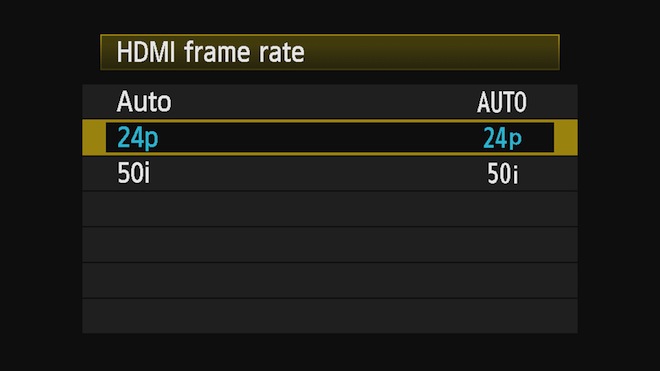
The HDMI output frame rates are 60i, 50i and 24p. There’s no 25p! The 50i is interlaced. That isn’t great news for PAL shooters. The actual frame rate in 24p mode is 23.976fps.
The HDMI output seems to have more of a green cast in the blacks than the internal recording.
The camera can record to the card whilst also recording via HDMI. When the Mirroring option is enabled in the menus, the camera will not display any icons or menus via HDMI and the LCD will remain on whilst an external recorder is attached.
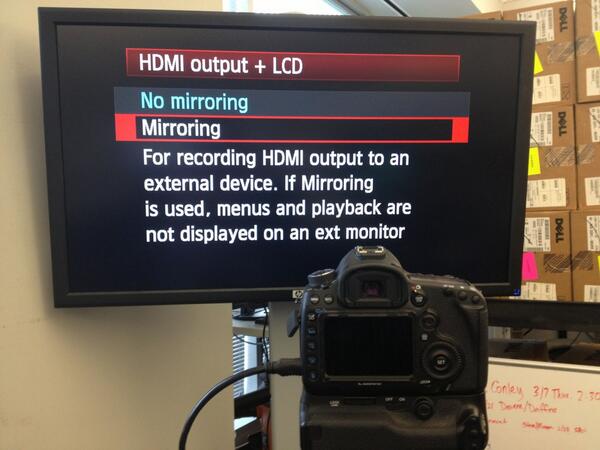
Thanks Rod on the EOSHD Forum for this image
On the Zacuto EVF via the Blackmagic HyperDeck Shuttle, only a 1:1 mapping of the upper corner of the image was displayed and none of the presets or scaling options got me the full image. I swapped to the Small HD DP6 only to find that in 24p mode it has a tearing of motion in the upper part of the frame, and only works when the HDMI is set to Auto or 50i. But I need it to be set to 24p for the recorder! I need to do further research here to find out if it is a HyperDeck Shuttle output or monitor issue.
On whether it is really 4:2:2 colour sampled as Canon claim I have my doubts. I don’t see any difference to the internal recording to suggest 4:2:2 and I doubt the sensor is sampling 4:2:2 from high resolution in video mode like a C300.
For now think of it is as 4:2:0 wrapped in 4:2:2 ProRes, try keying it and see if it meets your expectations (it is still only 8bit of course).
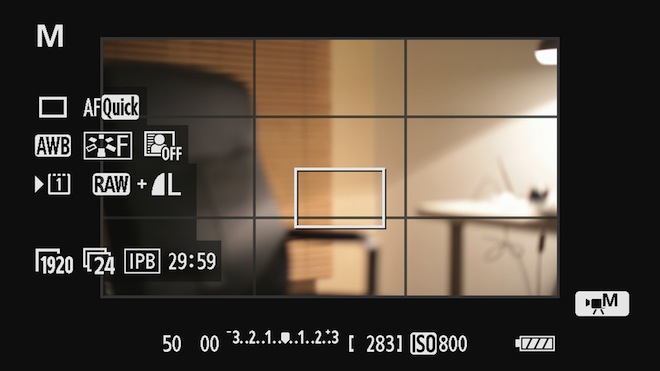
5D Mark III with Continuous RAW Video Recording
Huge thanks go to A1ex, g3gg0, 1% and the whole Magic Lantern team.
I have no other words to describe it – this is huge news.
Magic Lantern have done the seemingly impossible and given us a continuous raw recording mode on the Canon 5D Mark III. Once activated in the menus the 5D Mark III becomes essentially a full frame Blackmagic Cinema Camera and amazingly mine has not yet exploded. No more short bursts of raw, this is the real thing.
The image is leaps and bounds ahead of any other DSLR. We’re talking Alexa / Red league here, yet full frame. The first ever raw video shooting full frame camera at that. I’m getting continuous recording at a data rate to the card of 90MB/s and the camera hardly breaks into a sweat.
Here’s the option in Magic Lantern:
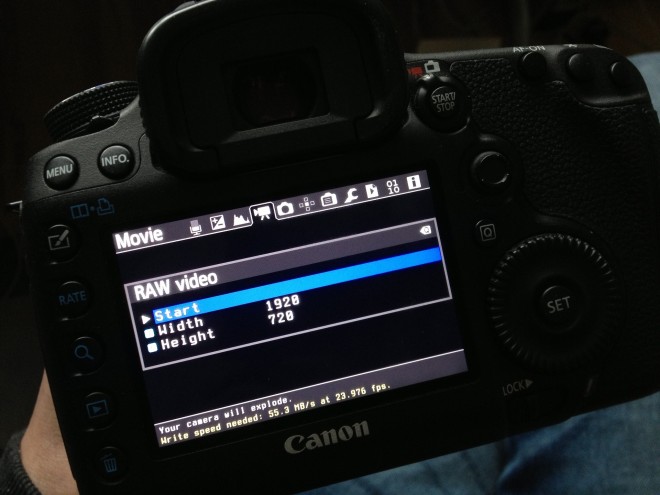
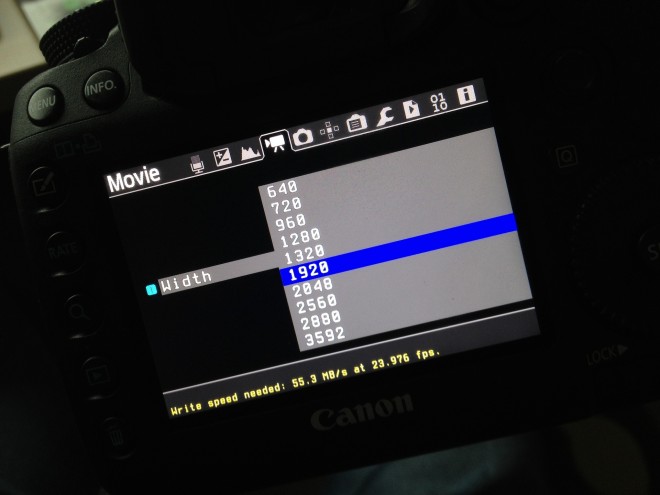
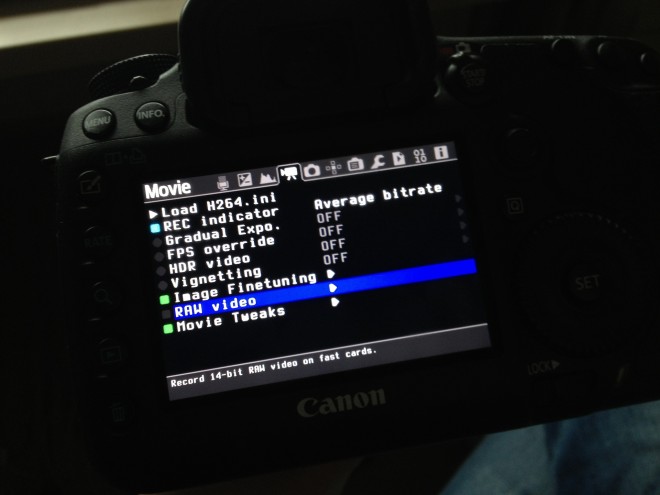
I shot the clips in the video above in 1920×1280 mode. I also have some 3.6K clips (3592×1320) too unfortunately they are glitchy with some drop frames, but 3K or 2.5K might be doable, especially with a narrower vertical crop… 3000×1000 maybe. That is approximately Micro Four Thirds area of the sensor at 1:1. The quality is the same as a raw photo. 14 bit, 12 stops dynamic range.
The 1080p raw file sizes are similar to 2.5K on the Blackmagic Cinema Camera. Around 4MB per frame for 1920×1280 (great aspect ratio for anamorphic lenses, utilising a higher than full HD vertical res) or a much more space efficient 2MB for 1920×720 (2.66:1).
You can also record plain old boring 1920×1080!
Needless to say you will need to invest in plenty of 1000x 64GB or 128GB cards especially for higher resolutions such as 3.5K which is over 7MB per frame!
Currently most of the action is being done on the 5D Mark III, once a reference version is finalised it will likely be ported to the 6D, 5D Mark II and even 600D. This is development code not finalised, not even Alpha yet. This is experimental code, just written.
Is heat an issue? Well I don’t know yet – I haven’t shot with it for long enough or in a hot enough place. The card and camera are warmer than normal, but that is to be expected considering the huge data rates generated by raw. I don’t know what – if any – implications for camera life this hack will have, but the sensor is always doing a raw video output in live view mode so sensor heat shouldn’t be any more of an issue than it was with ALL-I H.264 video.
Here’s a full 1920×1280 frame grab from raw. No more soft mushy Canon DSLR quality!

Click the image to enlarge
Breakthrough
As far as my belief goes the breakthrough involved a deeper understanding of the camera’s EDMAC (External DMA controller) and taking clean crops of the image buffer. Unlike in the burst mode, raw data is not converted to DNG format in-camera, you have to transcode it to DNG in post. This is good because you can do a very high quality debayer of the image on a powerful PC. To my eye the image looks better than with the previous nightly builds via DNG burst mode.
Developers can now write utilities to convert the 5D’s raw video files to Cinema DNG compatible with Resolve (not just standard DNG) and the camera can store raw clips in a single ‘.raw’ file. Magic Lantern themselves currently provide a converter for Windows (raw2dng.exe), hence the camera is freed up to just dump the data from the image sensor direct to the card.
The converter can also output to MJPEG if you want to avoid the workflow and get a project out of the door quicker. Even when converted to MJPEG it is a huge step up in image quality from the factory H.264. The camera now has a raw video menu where you can choose your resolution, and even a panning mode (like a digital dolly) in the 1:1 crop formats. The panning can move the sensor window around the frame whilst recording! Higher resolutions than 1920×1280 are a 1:1 crop of the sensor, up to 3592×1320. Here’s a partial list of the currently supported resolutions:
Full frame mode -
- 1920 x 1280 (3:2) – great for anamorphic
- 1920 x 1080 (16:9)
- 1280 x 720 (16:9)
- 1280 x 1280 (1:1)
- 3592 x 1320 – I get some drop frames at this res
- 2880 x 1320
- 2560 x 1080
- 1920 x 1080 (full HD crop mode like GH2)
- 1280 x 720 (the lower the resolution the more telephoto the crop)
The raw format is 14bit linear uncompressed RGGB raw.
Workflow
Raw2dng.exe is currently very simple and runs at the command prompt in Windows, you specify the raw filename and away it goes. After that is done you simply import the DNGs as a sequence into After Effects, though there is a variety of other ways to do it not involving Adobe software. The good thing is that the camera records the raw data to ONE single file in-camera, making it easier to manage your clips on the card. There’s no playback of raw in-camera yet, but live view remains on whilst recording. I am sure a thumbnail reference can be created for clips later.
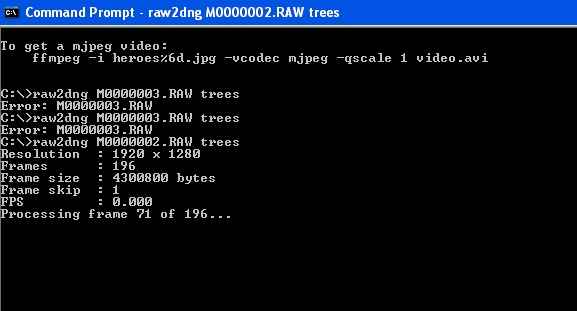
This continuous raw recording mode came about from a separate development branch of Magic Lantern to the very cool DNG burst stills silent pics. It started off as a module to record raw YUV 422 image data to the card. The burst mode is still in there if you need DNG straight out of the camera and that will remain as a stills feature.
Alex of Magic Lantern rewrote an entire module (lv_rec) to make this happen and you can take a look at some of the source code for the raw recording module here.
The world just exploded
Yes the world just turned on its head and I have no idea what the implications for the market are going to be yet, other than that now Canon’s DSLRs, through no action at all from Canon themselves just became a whole lot more serious as cinema cameras.
There’s no doubt the raw images from the 5D Mark III exceed the quality you get from Canon’s much more expensive cameras, like the C300. The 1D C now also has some serious competition from much cheaper DSLRs. I feel Blackmagic could lose most from this though, and will be a shame if that happens. I’ve not yet tested them head to head but the sensor in the 5D Mark III is far more capable than the one in the Blackmagic Cinema Camera in many ways – generating clean moire free images especially in 1:1 crop mode and cleaner high ISO images from a much larger sensor. The BMCC is no longer as attractive to me.
The 5D Mark III is now top dog for video quality, far surpassing the GH2 and GH3. All this is rather tragic, because quite simply, Canon don’t deserve this success. It is entirely of Magic Lantern’s making, and they did it for us free.
mercoledì 8 maggio 2013
No 7D Mark II in 2013?
![No 7D Mark II in 2013? [CR2]](http://www.canonrumors.com/wp-content/themes/magnet/scripts/timthumb.php?src=http://www.canonrumors.com/wp-content/uploads/2012/09/eos-7d-official-rm-eng.jpeg&a=t&h=200&w=475)
From a good source, we’re told that an EOS 7D Mark II will not be released in 2013. We could get an announcement sometime in this calendar year, but availability will be next year.
The only DSLR still to come in 2013 from Canon is the EOS 70D. The same source does say “several lenses will be coming in 2013″.
2014 will be the year for high-end DSLR cameras from Canon, consider this a down year for bodies.
Review – Canon EF 24-70mm f/4L IS
Review – Canon EF 24-70 f/4 L IS
By: Justin VanLeeuwen
Last year Canon released the 24-70 f/2.8 L II to much fanfare and praise, but there were a few who were lamenting the lack of what seems to be a staple in all new lenses: image stabilization. There were rumours of an IS version being tested in the wild, but what some were surprised to see when it was finally announced was that it was to be a 24-70 f/4 IS. Fast primes and wide-open zooms get most of the glory in photography. Dreamy, creamy shallow depth of field is nice, but sometimes an image calls for more depth and sharpness. Sometimes a photographer doesn’t need the financial and weight trade-off a faster lens gets you. Sometimes they need something that simply does the job. In my commercial work, I often find myself shooting at apertures of f/5.6 to f/11. Is a 2.8 lens really necessary on those jobs or does the f/4 serve the purpose?
Build
When I first received the Canon 24-70mm f/4 L IS, I had just finished a few weeks of working with the Canon 24mm f/1.4 L II. I was shocked at how they were almost the same size and how the zoom weighed far less. Alone it may not be so obvious, but compared to the Canon 24-70 f/2.8 L (which I own) or the Canon 24-70 f/2.8 L II (which I reviewed), the Canon 24-70 f/4 L IS is drastically smaller and lighter. The body is of a mixed plastic and metal design, but don’t let that “plastic” turn you off, it feels incredibly robust and sturdy.
The lens’ body has the standard “AF/MF” switch, as well as the stabilizer’s “On/Off” switch (no explanation needed). However, opposite to these, there is a clever little “Macro/Lock” switch. The lock is pretty straightforward: by pulling the switch back towards the camera, you prevent the lens from accidentally extending. A nice touch to the lock is that the lens will break free with a soft “click” when you turn the zoom ring. No chance of ruining the lens by force if you’ve locked it and forgotten; not that it was loose when it wasn’t locked, but zooms do loosen with use and age. When you’re zoomed in at 70mm and want to get in closer to your subject, pressing that same switch forward will allow you to zoom into the “macro” range. I will note that, while handy in a pinch, the physical working distance to objects is incredibly close, so close as to block off light and bump the lens hood against anything you’re trying to photograph. Unlike locking at 24mm, you have to push the switch forward again to disengage from macro mode and resume shooting in your normal 0.38m-5m focus range. (an interesting note, exif data reads out Macro at “80mm”>
The focus and zoom rings are a good size, the rubber grip is relatively small at just over 1 cm wide compared to much larger lenses, but not so diminutive as to be unusable or even frustrating. I don’t know how this applies to video rigs that rely on focus shifts, but for stills they’re well placed and easy to use.
AF is fast and accurate. At no point did I have any issues with the AF, the noise, the speed or anything; it just works, and works well.
The front lens element has a familiar 77mm thread, so many of my filters already fit and work with it. Canon has also included their own version of the popular centre-pinch-lens cap. While this is a nice design, I didn’t exactly dislike the older lens caps except, perhaps, on telephoto lenses with their hoods attached which benefit from the centre-pinch style. In most cases I felt the caps were secure and held well. Maybe I just have to get used to it, but I sometimes found myself misplacing the cap on the front of the lens, and it popped off in my bag a few times.
Overall this is a true “L” series lens, from weather-sealing at the base to the high-quality front element, you can be sure this lens will withstand more than a few bumps and bruises.
Image
Let’s be honest, f/2.8 gets all the love. Why? The obvious arguments are for separation of your subject from the background with a shallow-depth of field, and low-light situations. I can shoot at 70mm f/4 and get a respectable amount of background blur, not to mention my subject is mostly in focus now. I can’t say the same for faster lenses. With every new generation of camera body, comes a significant advancement of low-light gathering abilities. The high ISO’s in todays camera allow you to easily stop your camera down for added clarity and depth in the scene. Like most (all?) lenses, the Canon 24-70 f/4 L IS vignettes wide-open at f/4 across the focal range, worse at the wider end, and it improves slightly as you stop down. Another issue is that at 24mm, the image is very distorted. This is also correctable in software, but combined with heavy vignetting even up to f/8, you’re looking at some significant compromise.
I don’t run any sharpness test, and neither do my clients when I submit work; you can find those all over the internet from people interested in that level of accuracy. I can see the lens is perfectly sharp for my needs, even wide-open. I think that at f/4 it’s better than my Canon 24-70 f/2.8 L, but can’t say that it’s the case for the 2.8 version II. That lens was ridiculously good, and it would be hard to improve on it, especially stopped down to its sweet-spot.
I was impressed with how well this lens handled chromatic aberration. I shot a on an overcast day with snow on the ground – perfect light to dark conditions that make it stand out – and there was some chroma, mostly at the lens edges, but it was hardly noticeable.
Image Stabilization
People make a big deal about IS, and I absolutely love it on telephoto lenses. Stabilization helps reduce the lowest usable shutter speed at a given focal length. So on a 200mm lens and a full-frame camera body, you would want a shutter speed of at least 1/200th of a second to get relatively sharp results and 1/80th at 70mm. That said, IS doesn’t stop action, or your subjects from moving – it helps lock up your own camera shake. It’s handy in tight situations, and if you need to shoot at 1/40th or 1/60th of a second it will certainly help. I’ve never been overly concerned about my ability to hand-hold 24mm at 1/25th of a second or less, but having it certainly won’t hurt. Clearly it’s even better suited for subjects that already don’t move in dark situations where the IS will effectively counter camera-shake.
Who’s it for?
Lightweight, wide-angle to telephoto with macro capabilities (albeit not particularly useful) and image stabilization make this an ideal landscape photographer’s lens. 24 mm is very common for use in the field, and the versatility of a zoom just buys the photographer more options. As I mentioned, it’s as small as the 24mm prime, and weight is everything if you’re out trekking for a few days.
Commercial photographers working indoors but requiring totally in-focus and sharp portraits will welcome its slightly lower cost than the f/2.8 II’s, and will benefit from the versatility IS buys them at slower shutter speeds. Of course, if you’re working with a flash, you may want to choose something with a bit more output, as the smaller aperture requires more light.
While I never bring my 24-70 f/2.8 L to architectural shoots because of its weight, I might be more inclined to bring the 24-70 f/4 L IS along. It may not replace my 24mm f/3.5 L tilt-shift, but the other focal lengths could certainly come in handy, and it might be a good lens for someone looking to get into interior work. Vignetting at f/4 might be an issue, but much of that kind of work is shot well above that aperture.
Travel photographers or hobbyists who just like good images will welcome the light weight and popular zoom focal range. Travelling light and inconspicuously is an advantage and the lens is short enough to not draw too much attention to itself.
While 70mm still isn’t a particularly strong telephoto zoom, it will work well in a kit paired with some primes, or more obviously the Canon 70-200 f/4 L IS; these two lenses were made for each other. As of now, Canon has created a secondary f/4 “Trinity” of lenses if you include the 17-40 f/4L.
Conclusion
If you’re a bokeh-loving wide-open lens kind of person, you’ve probably already dismissed this lens. F/4 isn’t in your vocabulary. Some of us appreciate a depth to our images that can reveal layers of detail and interest. Yes, the faster lenses, when stopped down, will likely be sharper at f/4. In the case of the 24-70 f/2.8 L II, it will also cost you significantly more. As far as cost is concerned, I do find the current SRP on the 24-70 f/4 L IS a bit high, higher than when I purchased my 24-70 f/2.8, but still lower than the version two release. These prices drop and settle over time, but like most things, there’s a price to owning the latest and greatest gear.
Zooms can replace a number of primes, allowing photographers to work faster without having to swap lenses to reach a different focal length, or achieve a certain level of telephoto compression. You can quickly switch from a 24mm environmental portrait to a 70mm headshot. The compact nature of the zoom saves even more space in your kit, giving you room in your bag, or the ability to travel smaller and lighter.
I’ve never found the 24-70 focal range particularly exciting. It’s not wide enough to create an interesting level of distortion, nor so telephoto as to create a special compressed and isolated “look” to your subjects. I never LOVED my 24-70 f/2.8 L, I just used it every day. Like that lens, the 24-70 f/4L IS is a tool; one that is more than capable of getting the job done.
Pros
By: Justin VanLeeuwen
Last year Canon released the 24-70 f/2.8 L II to much fanfare and praise, but there were a few who were lamenting the lack of what seems to be a staple in all new lenses: image stabilization. There were rumours of an IS version being tested in the wild, but what some were surprised to see when it was finally announced was that it was to be a 24-70 f/4 IS. Fast primes and wide-open zooms get most of the glory in photography. Dreamy, creamy shallow depth of field is nice, but sometimes an image calls for more depth and sharpness. Sometimes a photographer doesn’t need the financial and weight trade-off a faster lens gets you. Sometimes they need something that simply does the job. In my commercial work, I often find myself shooting at apertures of f/5.6 to f/11. Is a 2.8 lens really necessary on those jobs or does the f/4 serve the purpose?
Build
When I first received the Canon 24-70mm f/4 L IS, I had just finished a few weeks of working with the Canon 24mm f/1.4 L II. I was shocked at how they were almost the same size and how the zoom weighed far less. Alone it may not be so obvious, but compared to the Canon 24-70 f/2.8 L (which I own) or the Canon 24-70 f/2.8 L II (which I reviewed), the Canon 24-70 f/4 L IS is drastically smaller and lighter. The body is of a mixed plastic and metal design, but don’t let that “plastic” turn you off, it feels incredibly robust and sturdy.
The lens’ body has the standard “AF/MF” switch, as well as the stabilizer’s “On/Off” switch (no explanation needed). However, opposite to these, there is a clever little “Macro/Lock” switch. The lock is pretty straightforward: by pulling the switch back towards the camera, you prevent the lens from accidentally extending. A nice touch to the lock is that the lens will break free with a soft “click” when you turn the zoom ring. No chance of ruining the lens by force if you’ve locked it and forgotten; not that it was loose when it wasn’t locked, but zooms do loosen with use and age. When you’re zoomed in at 70mm and want to get in closer to your subject, pressing that same switch forward will allow you to zoom into the “macro” range. I will note that, while handy in a pinch, the physical working distance to objects is incredibly close, so close as to block off light and bump the lens hood against anything you’re trying to photograph. Unlike locking at 24mm, you have to push the switch forward again to disengage from macro mode and resume shooting in your normal 0.38m-5m focus range. (an interesting note, exif data reads out Macro at “80mm”>
The focus and zoom rings are a good size, the rubber grip is relatively small at just over 1 cm wide compared to much larger lenses, but not so diminutive as to be unusable or even frustrating. I don’t know how this applies to video rigs that rely on focus shifts, but for stills they’re well placed and easy to use.
AF is fast and accurate. At no point did I have any issues with the AF, the noise, the speed or anything; it just works, and works well.
The front lens element has a familiar 77mm thread, so many of my filters already fit and work with it. Canon has also included their own version of the popular centre-pinch-lens cap. While this is a nice design, I didn’t exactly dislike the older lens caps except, perhaps, on telephoto lenses with their hoods attached which benefit from the centre-pinch style. In most cases I felt the caps were secure and held well. Maybe I just have to get used to it, but I sometimes found myself misplacing the cap on the front of the lens, and it popped off in my bag a few times.
Overall this is a true “L” series lens, from weather-sealing at the base to the high-quality front element, you can be sure this lens will withstand more than a few bumps and bruises.
Image
Let’s be honest, f/2.8 gets all the love. Why? The obvious arguments are for separation of your subject from the background with a shallow-depth of field, and low-light situations. I can shoot at 70mm f/4 and get a respectable amount of background blur, not to mention my subject is mostly in focus now. I can’t say the same for faster lenses. With every new generation of camera body, comes a significant advancement of low-light gathering abilities. The high ISO’s in todays camera allow you to easily stop your camera down for added clarity and depth in the scene. Like most (all?) lenses, the Canon 24-70 f/4 L IS vignettes wide-open at f/4 across the focal range, worse at the wider end, and it improves slightly as you stop down. Another issue is that at 24mm, the image is very distorted. This is also correctable in software, but combined with heavy vignetting even up to f/8, you’re looking at some significant compromise.
I don’t run any sharpness test, and neither do my clients when I submit work; you can find those all over the internet from people interested in that level of accuracy. I can see the lens is perfectly sharp for my needs, even wide-open. I think that at f/4 it’s better than my Canon 24-70 f/2.8 L, but can’t say that it’s the case for the 2.8 version II. That lens was ridiculously good, and it would be hard to improve on it, especially stopped down to its sweet-spot.
I was impressed with how well this lens handled chromatic aberration. I shot a on an overcast day with snow on the ground – perfect light to dark conditions that make it stand out – and there was some chroma, mostly at the lens edges, but it was hardly noticeable.
Image Stabilization
People make a big deal about IS, and I absolutely love it on telephoto lenses. Stabilization helps reduce the lowest usable shutter speed at a given focal length. So on a 200mm lens and a full-frame camera body, you would want a shutter speed of at least 1/200th of a second to get relatively sharp results and 1/80th at 70mm. That said, IS doesn’t stop action, or your subjects from moving – it helps lock up your own camera shake. It’s handy in tight situations, and if you need to shoot at 1/40th or 1/60th of a second it will certainly help. I’ve never been overly concerned about my ability to hand-hold 24mm at 1/25th of a second or less, but having it certainly won’t hurt. Clearly it’s even better suited for subjects that already don’t move in dark situations where the IS will effectively counter camera-shake.
Who’s it for?
Lightweight, wide-angle to telephoto with macro capabilities (albeit not particularly useful) and image stabilization make this an ideal landscape photographer’s lens. 24 mm is very common for use in the field, and the versatility of a zoom just buys the photographer more options. As I mentioned, it’s as small as the 24mm prime, and weight is everything if you’re out trekking for a few days.
Commercial photographers working indoors but requiring totally in-focus and sharp portraits will welcome its slightly lower cost than the f/2.8 II’s, and will benefit from the versatility IS buys them at slower shutter speeds. Of course, if you’re working with a flash, you may want to choose something with a bit more output, as the smaller aperture requires more light.
While I never bring my 24-70 f/2.8 L to architectural shoots because of its weight, I might be more inclined to bring the 24-70 f/4 L IS along. It may not replace my 24mm f/3.5 L tilt-shift, but the other focal lengths could certainly come in handy, and it might be a good lens for someone looking to get into interior work. Vignetting at f/4 might be an issue, but much of that kind of work is shot well above that aperture.
Travel photographers or hobbyists who just like good images will welcome the light weight and popular zoom focal range. Travelling light and inconspicuously is an advantage and the lens is short enough to not draw too much attention to itself.
While 70mm still isn’t a particularly strong telephoto zoom, it will work well in a kit paired with some primes, or more obviously the Canon 70-200 f/4 L IS; these two lenses were made for each other. As of now, Canon has created a secondary f/4 “Trinity” of lenses if you include the 17-40 f/4L.
Conclusion
If you’re a bokeh-loving wide-open lens kind of person, you’ve probably already dismissed this lens. F/4 isn’t in your vocabulary. Some of us appreciate a depth to our images that can reveal layers of detail and interest. Yes, the faster lenses, when stopped down, will likely be sharper at f/4. In the case of the 24-70 f/2.8 L II, it will also cost you significantly more. As far as cost is concerned, I do find the current SRP on the 24-70 f/4 L IS a bit high, higher than when I purchased my 24-70 f/2.8, but still lower than the version two release. These prices drop and settle over time, but like most things, there’s a price to owning the latest and greatest gear.
Zooms can replace a number of primes, allowing photographers to work faster without having to swap lenses to reach a different focal length, or achieve a certain level of telephoto compression. You can quickly switch from a 24mm environmental portrait to a 70mm headshot. The compact nature of the zoom saves even more space in your kit, giving you room in your bag, or the ability to travel smaller and lighter.
I’ve never found the 24-70 focal range particularly exciting. It’s not wide enough to create an interesting level of distortion, nor so telephoto as to create a special compressed and isolated “look” to your subjects. I never LOVED my 24-70 f/2.8 L, I just used it every day. Like that lens, the 24-70 f/4L IS is a tool; one that is more than capable of getting the job done.
Pros
- Compact and light-weight
- Image-stabilization for lower light/slower shutter speeds
- Reliable and quick autofocus
- Vignetting at f/4 where many faster lenses will have dispersed this
- Distortion across the focal range, specifically at 24mm
- Awkward macro mode
- f/4 aperture may just not appeal to some
Iscriviti a:
Post (Atom)

